- Details
- Written by: Gianna Esquivel
- Hits: 1514
Today we arrived in Greece! We are very excited and we are dying to see the Aegean Sea in person hahaha All those amazing pictures of the Greek beaches people post on the Internet are about to become real. We can’t wait! So we are heading directly to the beach! We will explore Northern Greece, starting with Fanari and its surroundings. Are you ready?
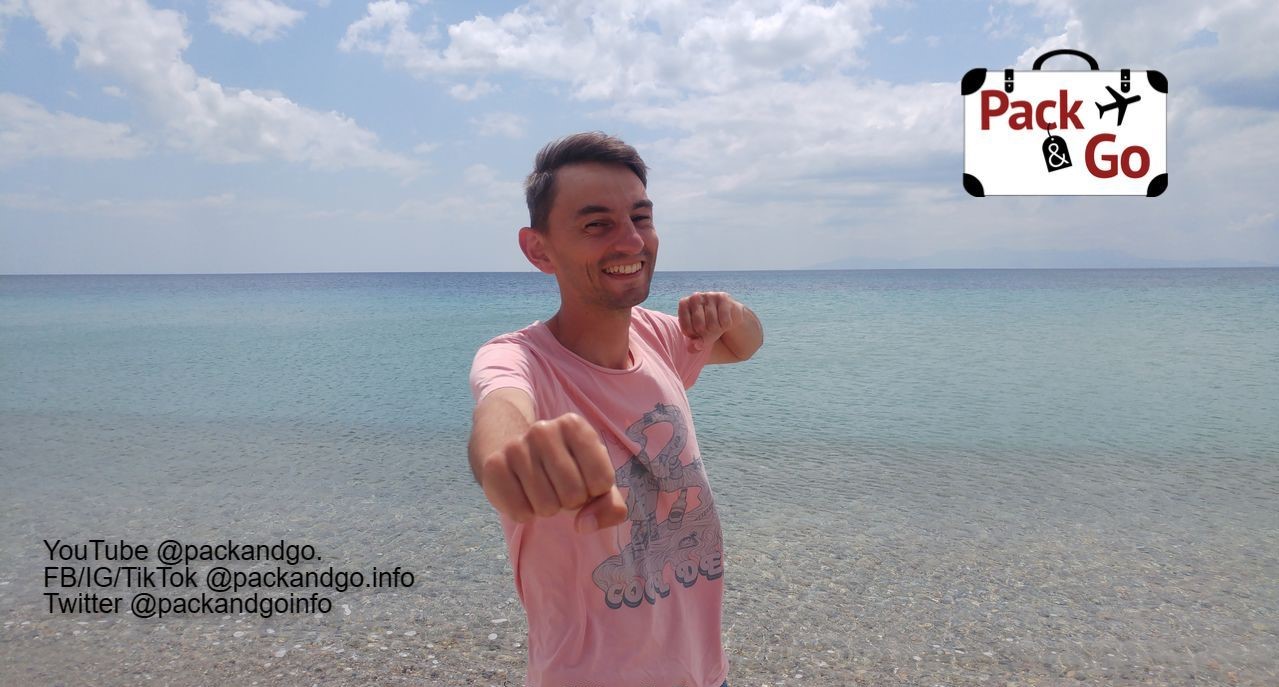
Where is Fanari?
Fanari or Fanarion (official name) is a small village located on the seaside in northern Greece. Take your map and follow these references. Based on Google Maps calculations, Fanari is:
- 386 km (4 hr. 35 min.) from Sofia (София), Bulgaria (BG).
- 201 km (3 hrs. 5 min.) from Plovdiv, BG.
- 106 km (1 hr. 26 min.), from Kardzhali (Кърджали), BG.
- 235 km (2 hr. 45 min), from Tekirdağ, Türkiye (TR).
- 88 km (1 hr 10 min), from Alexandroupoli, Greece (GR).
- 32 km (30 min.), from Komotini, GR.
- Xhanti 37 km (34 min.), from Xhanti, GR.
Fanari belongs to the Municipality of Komotini of the Regional Unit of Rodopi. It is a littoral settlement. It is 16 meters above sea level. Its population is estimated at 700 permanent residents.
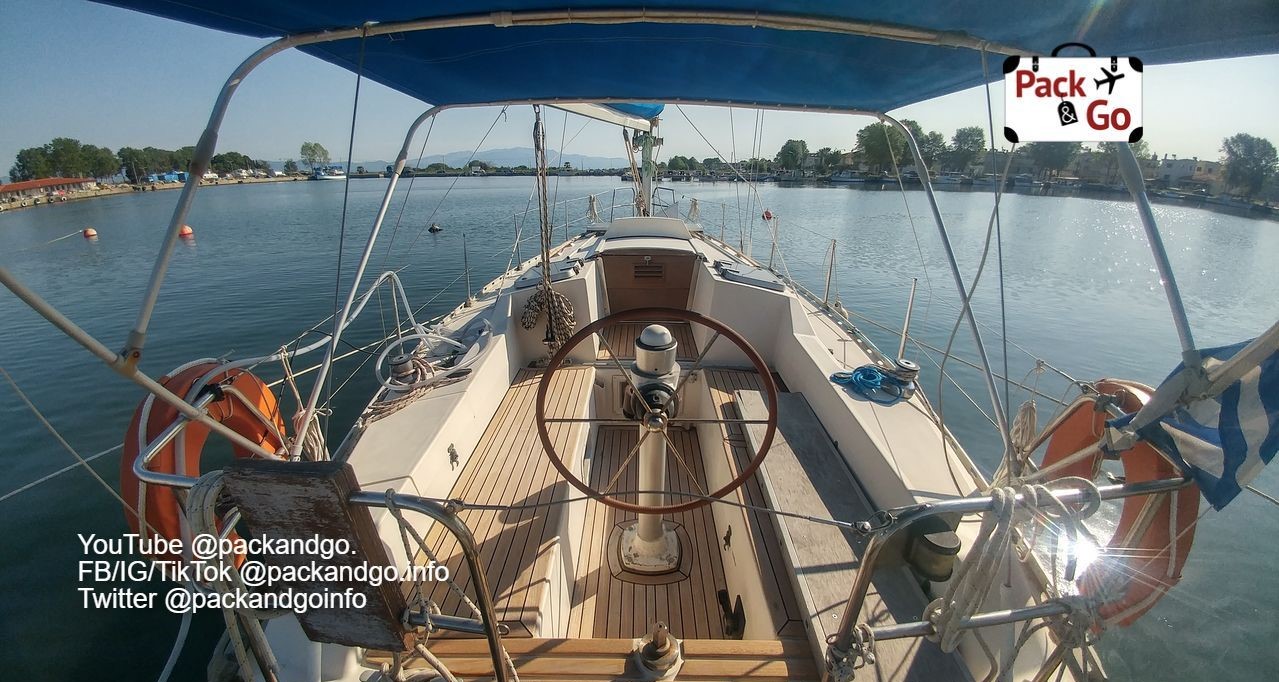
What is the meaning of Fanari?
Fanari means lighthouse. The name comes from the Greek φάρος (fáros). The village was named Fanari because its original center was established on the headland where the lighthouse was.
History of Fanari
When you arrive in Fanari village and see its beauty and the awesome Aegean sea, you barely reckon about its history. It’s like “Who cares? It is beautiful! That’s it!” hahaha. But come on! A bit of history does not hurt! hahaha.
Fanari's foundation goes back to 1923 when the Peace Treaty of Lausanne was signed. The objective was to establish the borders, exchange war prisoners, and relocate civilians after the war between Greece and Türkiye. Fanari and other villages around were founded by Greek refugees from Eastern Thrace, currently, Türkiye. Fishing, agriculture, and trade were the main activities in Fanari.
During World War II, Fanari, like many other Greek villages, was impacted by the German occupation. Locals took part in the resistance against the occupying forces. After the war ended, Fanari’s reconstruction and development took place. Fishing and agriculture (olive groves, vineyards, etc.) remained as main activities.
During the latest decades, Fanari has modernized and improved its infrastructure, transportation, and amenities. Residents’ quality of life has become better and the village more accessible for visitors. That is how, Fanari is now an important tourist spot in Rodopi, both for locals and tourists from neighboring countries like Bulgaria, Türkiye, Romania, and Serbia!
Since the moment we arrived in Fanari, the Bulgarian presence was very clear. We can say that roughly, from every 10 cars in Fanari, 6 had Bulgarian plates.
| Follow PackAndGo.info at: | |
| YouTube | @packandgo. |
| @packandgo.info | |
| X | @packandgoinfo |
| Bluesky | @packandgo.bsky.social |
| @packandgo.info | |
| TikTok | @packandgo.info |
What to do in Fanari?
Fanari is a small village ideal for you to relax and enjoy the beach, nature, and that slow pace coastal spots offer. It is the ideal destination if you are looking for a beautiful, comfortable, and quiet place to rest. Although the increase of tourists the village has experienced during recent years, it is not as crowded as other popular destinations in Greece. Besides, we arrived in May 2023 and we found only the local people and a few tourists, mostly Bulgarians. Some of them were there only for short stays, like a day or a weekend. May is still low season so if you arrive in July or August, for sure you will find more visitors.
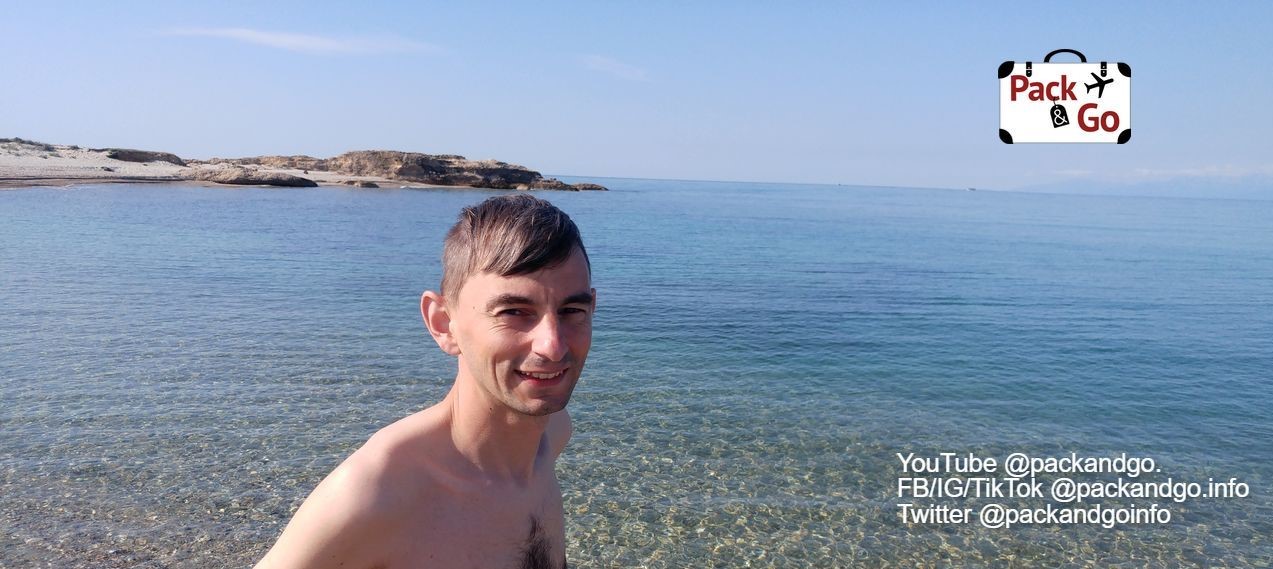
What to do in Fanari? Well, of course, you can explore the village and its surroundings, but you can also enjoy the awesome pleasure of doing nothing… Ok, nothing more than jumping into the sea, enjoying the beach, and fulfilling your soul with the beautiful landscape and your belly with delicious Greek food and drinks. This was a very tempting plan we did not refuse! Hahaha. Ok, here you have what to do in Fanari!
Swim and enjoy the beaches
Fanari owns beautiful beaches, one (the longest) has the blue flag tag, an indicator of quality standards and environmental safety. The beaches are pleasantly sandy! During May, the water is cool, some can say “still cold”, but we will say, just a little bit cold. And honestly, to have this beauty only for yourself, without sharing it with hundreds of tourists, is worth not waiting until the high season (Summer). The shallow waters of these beautiful beaches are a big plus for families, kids, and people who don’t know how to swim. The currents at the time we were there were very calm.
We were moving from beach to beach only to change the view. Here kind of our daily routine there:
- Beach at the port of Fanari. We visited it for an early swim. The only people we saw there, were local fishermen working on their boats and Bulgarian fishermen who enjoy this activity as a hobby. It was easy to enjoy the tranquility of this nice, sandy, and for moments, a bit rocky beach.
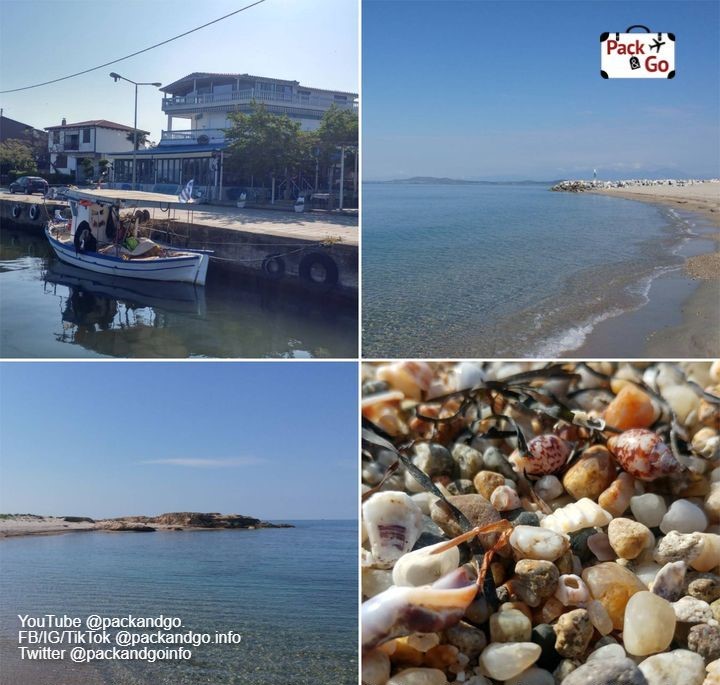
- Central beach. We moved to the central beach in front of the restaurants and cafes to have meals, and delicious hot coffee and cold Greek coffee (frappé, freddo espresso, or freddo cappuccino). Since the restaurants are here, they are a magnet for people. We were very lucky because, by the time we were there, neither the restaurants nor the beach were crowded. Only during the weekend, more visitors arrived to have a coffee or spend the day in the village.
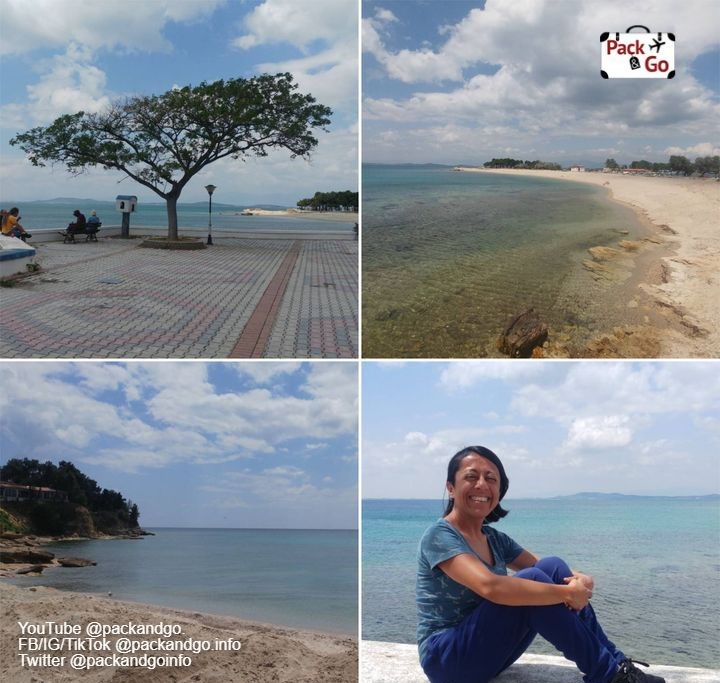
- Arogi-Fanari Beach. This is the longest beach in Fanari. After breakfast, we walked on this beach that connects Fanari with the nearby village called Arogi. You can walk as long as you want on this pleasant, sandy, and peaceful beach. The absence of commerce or big development around makes this area more secluded and tranquil. You only need to take with you water and sunblock! That is it!
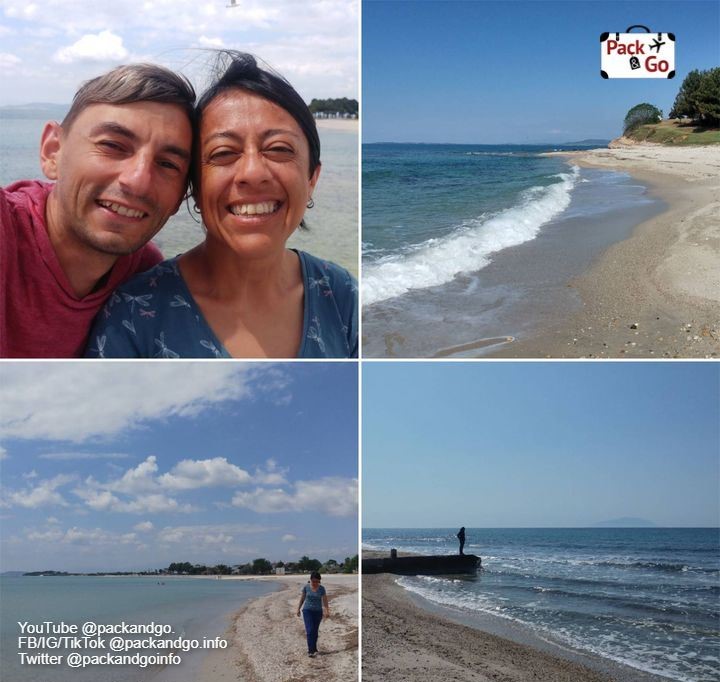
Fishing
We have not trained for fishing yet, but as we told you before, we found Bulgarian enthusiasts of this activity there. One day, while enjoying the sunrise, we greeted some fishermen in Greek, “Καλημέρα (Kalimera)!”. Then, they answered, “добро утро (dobro utro)!” hahaha. Come on! They were Bulgarians! Hahaha. They ruined what with thought was our first friendly encounter with Greek people. But they gave us a fun time and some cool tips for fishing!
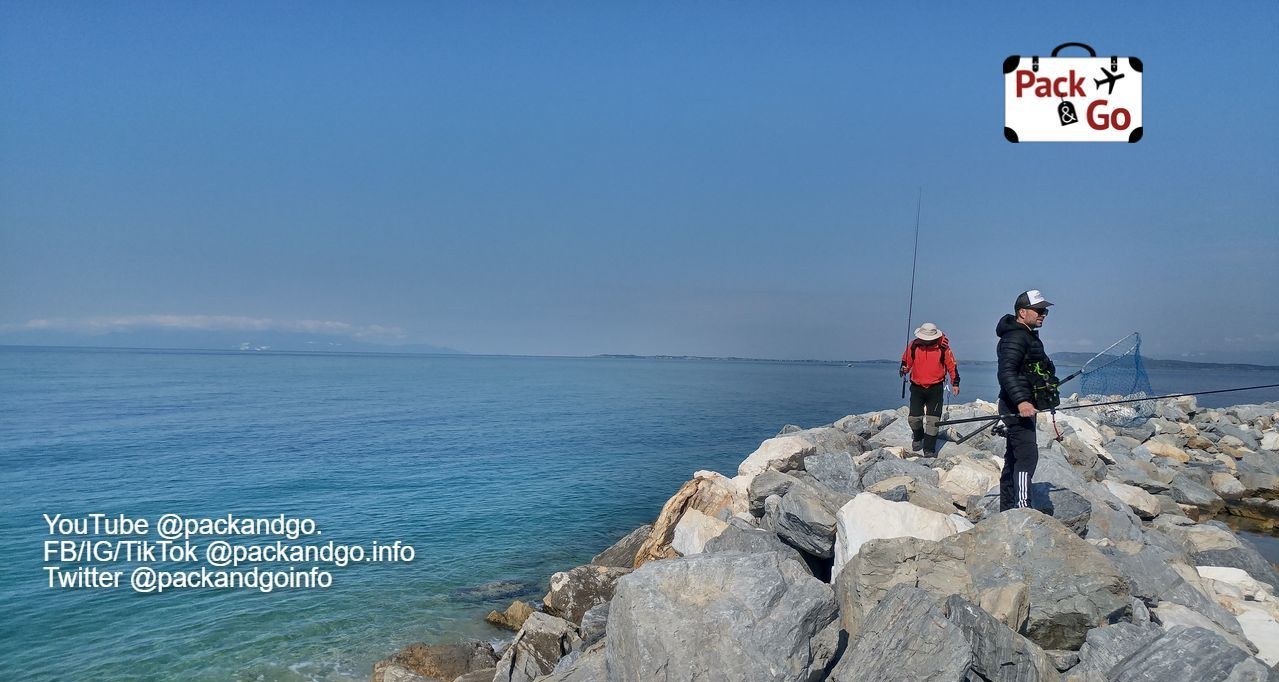
They were from the southern city of Kardzhali, BG. For them to visit Fanari is a relaxing hobby together with fishing. They like so much the shallow and clear waters of the Aegean Sea, so they come to spend long stays, especially during the Summer, but also a day or several hours only to relax, fish, and get back home (Bulgaria) with fresh fish for dinner. If you are into making new friends, meeting Bulgarians can be another cool thing what to do in Fanari, Greece hahaha.
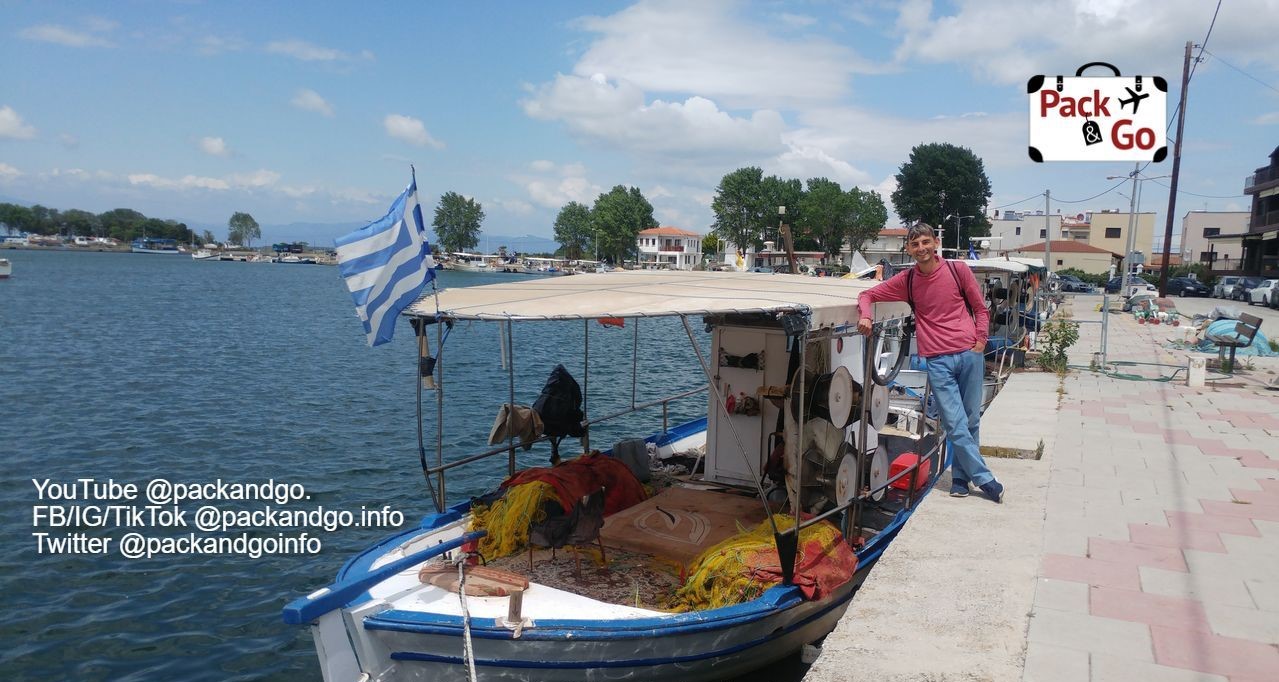
Cycling around
Tourists carrying their bicycles in their cars or campers was a constant while being in Fanari. Luckily, the landlord of the apartment we rented offered us bicycles to go around. It is not a rule but you can rent a bicycle or motorbike in some guest houses and hotels. It is a great way to go around Fanari village, its beaches and even to reach the next villages for more exploration. The terrain is mostly flat, the roads are good and we felt the whole area was pretty safe.
Sunset and sunrise spotting
Words can’t express how big fans of sunsets we are! The horizon in front of you, defined by the immensity and clarity of the sea, together with the changing colors of the sky that are reflected in the sea, wow! It is perfect! And very romantic too hahaha. Well, a big advantage of this village is that not only sunsets but also awesome sunrises can be seen in Fanari. We admired great sunsets from the beach at the port and lovely sunrises from the Arogi-Fanari beach. This is only a personal preference, you can choose your favorite place for spotting sunsets and sunrises, and get amazing postcards (pics).
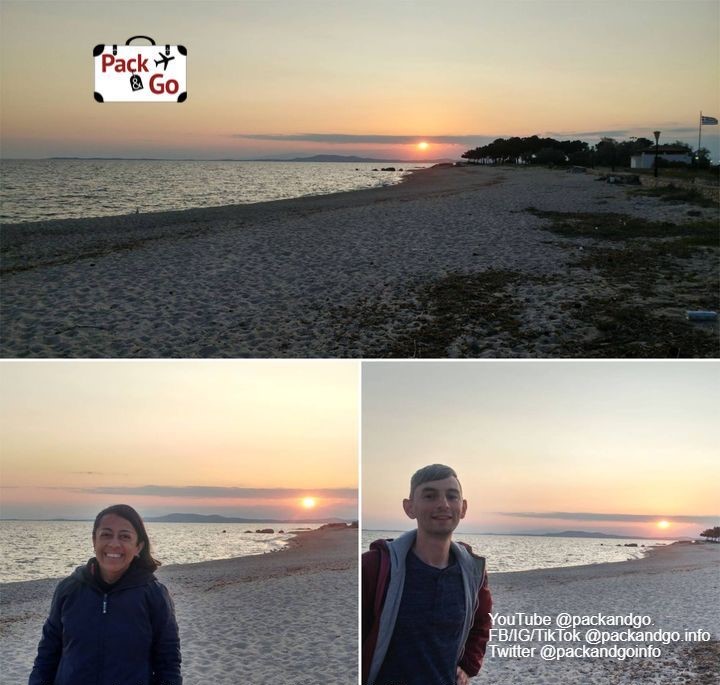
Taste Greek gastronomy
Fanari is a small fishermen's village, M is a fish lover so he expected to find an attractive variety of fish and seafood on the restaurants’ menus. Honestly, he was not impressed. The reason? He is Bulgarian and the fish offered in the menus are very common in the Black Sea coast too. You will find sardines and anchovies pretty much everywhere. There are other choices like burgers, pizzas, pasta, salads, pork, lamb, chicken, etc. We stuck to the Greek souvlaki and gyros. So, the fish variety was not impressive, but the Greek seasoning is good. You can eat tasty stuff from the morning to the night.
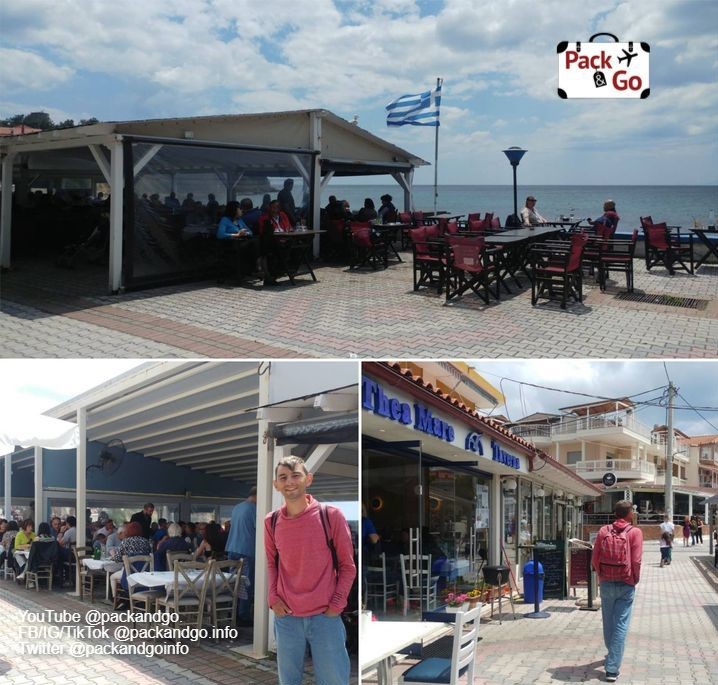
In a couple of restaurants, we saw that the fish was not fresh. The reason people gave was that during the low season, it is not lucrative to fish every single day. Ok, the problem for fish lovers is that being in a fishing village, you don’t feel like eating refrigerated fish. We choose places with fresh fish. Ultimately, it's a matter of taste.
One note here, menus are written in Greek, English, and BULGARIAN! So it is official, Fanari has been occupied by Bulgaria and locals know it well.
Drink Greek beverages
Beverages deserve a special mention because they are delicious and essential for Greeks' daily lives. The day can’t be started properly without a shot of hot coffee or even a cold one if the weather is already warm. Then, all along the day, you will see people drinking their different cold coffee choices, frappé, freddo espresso, or freddo cappuccino. They are delicious! Very early in this trip, we happily joined the Greek way hahaha. Later, after enjoying your meals, a shot of Ouzo or Tsipouro will be the digestive you need to reach “Nirvana” hahaha or just to hit the pillow to enjoy a nap. When it is to pleasures, Greeks are experts!
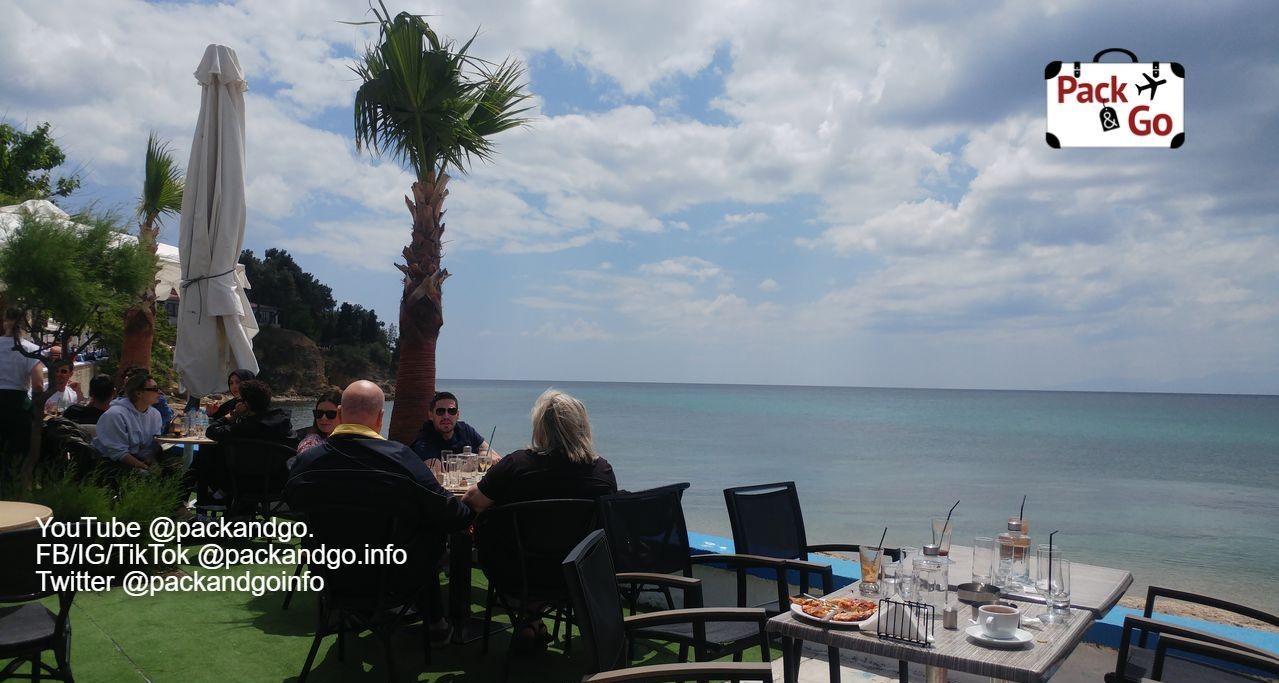
What to visit around Fanari?
If you want to explore more, the surroundings of Fanari will keep you entertained. This area is not as developed as other very famous cities or Greek islands. A large area houses natural ecosystems that have been left untouched to naturally flourish. Only 12 km north of Fanari is the Nestos National Park. You won’t see big and luxurious resorts, but nature and villages with a much more relaxed vibe. We love places like those still exist! These are our recommendations.
Porto Lagos and the Monastery Agios Nikolaos
Only 15 km (16 min. By car) northwest of Fanari, you will find Porto Lagos, where you can visit the Agios Nikolaos monastery (Xhanti region). It is an attraction because the complex was built on two small islets of the Porto Lagos lagoon, connected by a wooden bridge. On one islet, the Agios Nikolaos is. On the other, the Panagia Pantanassa chappel. The monastery seems to be floating framed by all that natural surroundings and enjoying an astonishing view, of the Thracian sea. It is an active place for believers and tourists.

Lake Vistonida
From the moment you arrive in Porto Lagos, you will see Lake Vistonida. You can explore more of this beautiful lake, home to different and interesting fauna. It is an ideal spot for nature lovers, photographers, and bird-watching enthusiasts. Pink flamingos are beautiful and popular there (March-October). All the region where Lake Vistonida lays is a protected habitat.
Arogi village
Only 4 km east of Fanari, Arogi village is. It is another calm place, very similar to Fanari, but still a good alternative for exploration. Nature is the constant there, nice beaches, nature trails for hiking, traditional Greek architecture, tasty local cuisine, and beverages.
Where to stay in Fanari?
Accommodation in Fanari won’t be a problem! The village has a lot of guest houses, small hotels, apartments you can rent (different sizes and costs)., and a camping site. Just consider that during the low season, many of these places are closed, so the choices get reduced.
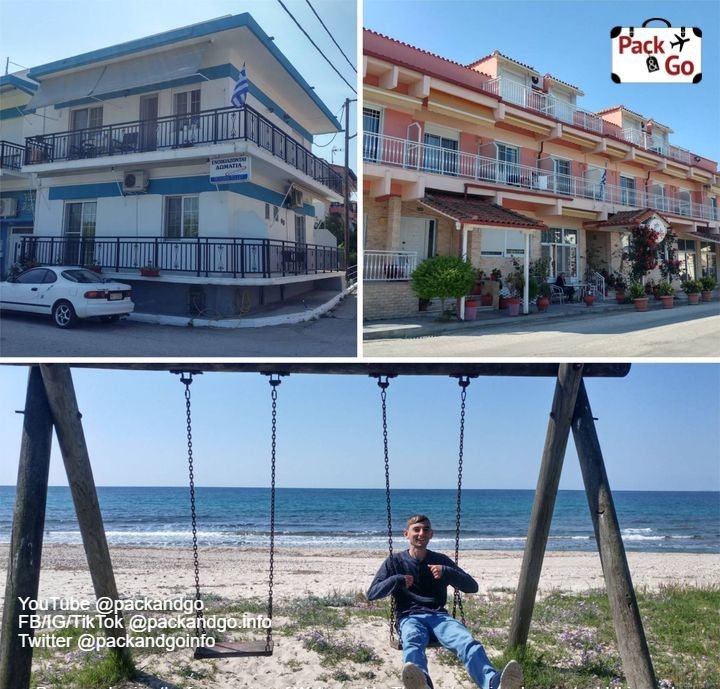
It is official, Fanari has been occupied by Bulgaria!
Bulgarians are big fans of Greece! Especially in northern Greece, we felt like we were still somewhere in Bulgaria. Daily, we found Bulgarians either at the beaches, on the road, at restaurants, in the accommodation, or in supermarkets. Greek people in the area also speak Bulgarian. We only can say, that the beauty of Greece is astonishing! It is impossible not to be conquered by it.
Conclusion
Fanari was our first stop on this trip through Northern Greece and it was perfect! We haven't enjoyed ourselves and relaxed as we did it here, a long time ago. The village has not the glam of the most famous Greek cities and islands but exactly that makes it very charming. We recommend you include Fanari in your travel list!
| Follow PackAndGo.info at: | |
| YouTube | @packandgo. |
| @packandgo.info | |
| X | @packandgoinfo |
| Bluesky | @packandgo.bsky.social |
| @packandgo.info | |
| TikTok | @packandgo.info |
- Details
- Written by: Martin Pramatarov
- Hits: 1195
Can you believe it? A Bulgarian city that is full of foreign tourists from Turkyie (Turkey) and Greece, but very few local tourists. Why is this happening? We went to Kardzali ourselves to find out. Is there something that keeps the local tourists away? Exploring all the places to visit in Kardzali, we made some very interesting discoveries. Find out what!
Where is Kardzali?
Kardzali (Кърджали), also spelled Kardzhali or Kurdzhali is a Bulgarian town located in the central part of South Bulgaria, next to the Arda River and Rodophe mountains.
When you look at the ma p of Bulgaria, locate Plovdiv, and from there go slightly southeast and you will see Kardzali.
If you a watching the map of Türkiye (Turkey), you will see Kardzali, west of Edirne.
And if you are checking the Greek map, you will find Kardzali, north of Komotini.
Some say that the name of the town comes from the Ottoman conqueror Kirca Ali, but Bulgarian historians say that is not true. The historian Boris Simeonov says that the name comes from the old Bulgarian language and the word “karchag”, meaning pottery. The place of the pottery makers.
| Follow PackAndGo.info at: | |
| YouTube | @packandgo. |
| @packandgo.info | |
| X | @packandgoinfo |
| @packandgo.info | |
| Bluesky | @packandgo.bsky.social |
| TikTok | @packandgo.info |
What to visit in Kardzali?
We were pleasantly surprised by the many interesting places to visit near Kardzali. You can spend a whole week around here, or even more if you are a lucky person with long holidays. Packandgo.info recommends you group some of the places to visit near Kardzhali per day.
For example:
Day 1: Utroba cave and the Devil’s Bridge.
Day 2: The stone wedding and Perperikon.
Day 3: River Arda and Tatul.
The Stone Wedding (Kamennata Svatba) (5 km way)
The stone wedding is a magnificent stone formation really close to Kardzhali. It is just around 5 km from Kardzhali. That makes it reachable not only by car but also by bicycle and even on foot. We usually don’t recommend taxis, but it could be a good option for a tourist group too.
We were quite lucky and there were no other tourists at the time of our visit. We could go around, take pictures from every angle, and even enjoy a small picnic there.
As we mentioned, Bulgarian tourists are staying away from Kardzhali and the foreigners don't know it.
The Stone Wedding has a legend:
A long time ago, there was a very beautiful woman. She was, so pretty, that everybody wanted her.
She fell in love with a brave man, and they were going to get married. The bride was ready and she was coming to the wedding together with all of her family and friends. At one moment, the wind blew her bridal veil and everybody saw her beautiful face. Because of her beauty, the men immediately desired her. That includes the father of the groom. God saw that and petrified everybody.
Back then, God was not merciful.
The Stone Wedding has a free entrance. You don’t need to pay anything.
The Mushroom Rocks (22km away)
The Mushroom rocks, also known as the Stone Mushrooms or Kamennite Gubi are a great rock formation near the village of Beli Plast, between Kardzali and Haskovo. They are called Mushroom rocks because they truly look like mushrooms. The Mushroom Rocks are around 22km away from Kardzali and it takes around 30 minutes to reach it by car.
They were made from volcanic tuffs (learn about volcanos) and they have multiple colors like pink, blue, and some black dots thanks to the mineral cloinoptilolite, manganese, and mineral celadonite.
The Mushroom rocks are around 2.5 to 3 meters high, and there are a bit more than 10 rocks.
By the way, Haskovo is also worth visiting. Check it out here!
If you are into cool rock formations, you can also check Belogradchik, or Sliven, and its blue rocks.
There is no entrance fee for the Mushroom Rocks near Kardzali. They are free to visit and you can stop your car at the entrance.
Utroba Cave (Womb Cave) (23 km away)
Utroba Cave is a very good hiking route near Kardzali. It is around 23 km away from the town and it takes around 45 minutes by car or around 1 hour and 15 minutes on bicycle. You should go towards Nenkovo village, and just a bit after the hut Borovitsa, you will see the sign that shows the start of the trekking. There is a small parking for a few cars. The hike is marked with a yellow sign on the trees and if you follow it more, you can go all the way to the Paradise Viewpoint of Arda River. We only took the route until the Utroba cave, and it took around 1 hour.
It does not require any special preparation, but still, it is a good effort. The terrain changes. First, it is a forest, then it is rocky. We went during the late spring and we were quite sweaty when we got to the top.
On the route, there are no shops, but there are a few benches and even kiosks that you can use to make a picnic. We saw some families that carried meat for BBQ.
Let’s get to the interesting part. Why it is called Utroba? Utroba Cave means Womb cave. It is called the Womb Cave because it has a similar shape to the female genitalia. Its entrance is 3-meter high, 2.5-meter wide, and it is 22-meter deep.
The Thracians, who lived here thousands of years ago, worshiped the Mother Goddess. The Utroba Cave has such a location, that the sun's rays enlighten the cave at a certain moment during the day, and that represents the fertilization that the Sun God performs with the Mother Goddess in order for the world to exist and be reborn. The Thracians created an altar, and the best time to see this is during the winter, between December and February.
Even now, many tourists from Türkiye (Turkey), Greece, and Bulgaria come here, to ask Mother Goddess for fertility. They bring food and other gifts to the altar.
Utroba (Womb) cave has a free access. You don’t have to pay anything.
Perperikon (20 km away)
Perperikon also known as Perperek is one of the greatest Thracian sentuaries in the world. It is ancient. The first settlement here was built in around 6000 B.C.!
It is located very close to Kardzali, around 20 kilometers, so you can go there by car or by a tour bus from Kardzali, or another close town. There is a paid parking and a free one. Depending on the season, you might be able to find a place on the free one.
There is also a small entrance fee that you need to pay at the entrance.
Perperikon is on a hill, around 500 meters high and you can enjoy a very beautiful view from every side of Perperikon.
The name Perperikon comes from the Middle Ages, between the 11th and the 13th centuries. The first name was Hyperperakion, but it was shortened to Perperakion and later to Perperikon. The name comes from the golden mines of Rodophes, and the process of refining gold.
The first civilizations here date back to the Bronze Age, and there are many ceramics found here in the Early Iron Age. There is also an impressive 2-meter in diameter altar made out of rocks.
It is believed that Perperikon was the place of the most famous Temple of Dionysis during the classical era.
Now you can see the remaining multiple-story palace with a very impressive fortress, with tick walls and even a preserved defense tower, and a church from the 5th century.
While we were enjoying the sanctuary, we started talking with a few of the tourists. They were a group of Turkish people, who used to be Bulgarians. How come? There was a very rude process in Bulgaria in 1984 called the "Revival Process", in which the government pushed all the ethically Turkish people, who were born in Bulgaria to change their names from Turkish names to Bulgarian names or leave the country. Become 100% Bulgarian or go away. A very extremist approach. Those who didn't want to do it emigrated to Türkiye (Turkey).
So, these guys were one of the people who decided to move to the neighboring country. They came for the first time to Bulgaria, after many decades to see the attractions, but also their abandoned houses. They had many memories of the rocks since they lived in the village nearby. They had tears on their faces, and an anger, that no "Sorry" can erase.
So this region of Bulgaria has not only ancient history but modern too.
Tatul Thracian sanctuary (28 km)
Tatul entrance fee for adults costs 6 BGN.
Tatul entrance fee for children and pensiones costs 3 BGN.
Tatul is a Thracian sanctuary and it could potentially be the tomb of the mythical musician Orpheus. We can’t be sure if Orpheus even existed, but what the stories tell is that he was a Thracian from the Rhodope Mountains. And on the top of Tatul, there is clearly a tomb of a famous person, so we decided to believe the myth.
Greek tourists get easily annoyed when another of the neighboring countries tries to claim something from their mythology, but let’s not focus on who is wrong and who is right. The place looks magnificent and full of energy anyway.
What you will find in Tatul is a well-preserved Thracian sanctuary that is located on a 200-meter high hill, near the town of Momchilgrad. The Tracian settelment is from 4000 B.C., and it consist of a rock piramid with a sarcophag and multiple althars.
During the years and the multiple archeological works there, the workers have found multiple pottery, bronze items, valuable items, and more. What is truly unique are the items dedicated to the Sun cult. Back in the day, the gods were directly related to nature and the Sun was one of the most popular ones.
Harman Kaya (Harmankaya) 31.5 km
Harman Kaya is a huge Thracian sanctuary in the Rhodopes from around 5000 years B.C. It is located near the village of Bivolyane.
What is really interesting about is that it is all cut inside the rocks.
The whole complex was developed next to a small, 7-meter-deep cave. There is also another cave there and both look like wombs. Just like most of the other Thracian sanctuaries in the area, there are cut niches inside the rocks that serve as holders of different items during religious ceremonies.
There is also a tomb cut inside the rock.
The main attractions here are the two so-called Harmans which are big circles cut inside the rocks. One is around 10 meters and the other is around 15 meters. What archeologists think is that they were used for astrological purposes. It is really curious to think, how ancient people from all around the globe were looking at the night sky and were trying to understand the world.
Monyak fortress 11.5 km
Visiting Monyak fortress near Kardzali, around 5 km, and it is a great hiking destination. It takes around an hour to climb to the Monyak fortress, and you will pass through forest and a bit rocky track. What is incredibly nice is that you can see the Arda River from the top.
The fortress of Monyak is located on the top of the Sixth Fortress peak, which is 586 meters high. The fortress was built around the 12th-13th century and used to be one of the important fortifications of Middle Age Bulgaria. The fortification had high walls, some of which were as high as 7.8 meters high, and the length of the wall was around 300 meters.
During the Middle Ages, the Monyak Fortress was an impressive stronghold. Bulgaria was often in conflict with Byzantine and there were many attacks of nomadic tribes coming from the east. A century later, after many years of battles, the Ottomans came to Europe and conquered Bulgaria.
Sadly, the Monyak fortress is not very well preserved and it is slowly falling apart. It would be nice if the Ministry of Tourism of Bulgaria started taking care of it.
The Horseshoe Bend of the Arda River (Golemia Zavoi na reka Arda) 30 km
If you are near Kardzali you can enjoy the beautiful Arda river and its multiple viewpoints. One of the best of them is the Horseshoe Bend of the Arda River (Horseshoe on Kardzali Dam). There, the river Arda makes a U-turn and it looks like a horseshoe.
It is on the road between Kardzali and Ardino. You need to turn in the village of Kobilyane and go direction of Borovitsa.
It is a hotspot for nature photographers and even if you are not a professional, you can make some stunning pictures here. It is a very popular destination for Instagram pictures too.
Devil’s Bridge (Diavolski most) 42 km
The Devil’s Bridge is a very impressive old bridge from the 16th century, near the town of Ardino. A long time ago, there was a bridge that was a part of the Via Egnatia, an ancient Roman road that connected Thracia, Macedonia, and Illyricum and went all the way to the Aegean Sea.
This bridge was destroyed, but in the 16th century, Sultan Selim the first order to be rebuilt. So, the current design is thanks to the Ottomans, and it looks spectacular.
The Thracian sanctuary Eagle Rocks (Orlovi Skali) 34.6 km
The Thracian sanctuary Eagle Rocks is another interesting sightseeing spot near Ardino (3 km away). The site consists of multiple niches, maybe around 100 niches are cut into a really large rock that is located above the forest.
It had some religious meaning, but sadly it was so long ago that the current historians don’t know the story. What some archeologist guess is that the place date back to the 2nd millennium B.C. and it was used through the Antiquity.
Now it looks like a really romantic place. Imagine if you could put candles inside the niches. Coming here with your partner, think about coming to Orlovi Skali late, enjoy the sunset, and put some candles for a nice romantic evening.
Thracian tomb of Aleksandrovo (Aleksandrovska grobnitza) 63.4 km
As you can see, this zone is full of myth and legend. One of them says that here in the village of Aleksandro, you can find the grave of the famous Alexander the Great. Is it true? In this article, we are truly triggering the Greek people. Now with Alexander the Great hahahah.
Probably we will never know if this is really his tomb, but there is an amazing tomb from the 4th century B.C. with well-preserved frescos and that is a fact.
You can visit it both from Kardzali and Haskovo.
What to do in Kardzali?
There are plenty of things to do in Kardzali and its surroundings.
-
Visit the Regional Historical Museum in Kardzali. You will learn a lot about thousands of years of history. The region is one of the most interesting ones in the world.
-
Eat Bulgaria, Turkish, and Greek cuisine. Enjoy some dunners, pide, moussaka, filled paprikas, sarmi, or another delicious dish from this part of the world. Which is the best? Try the 3! We love all of them and they all have special preparation methods.
-
Drink Bulgarian wine and Bulgarian rakia. The whole region of Thracia is well-known for its excellent wine for more than thousands of years. The first evidence of winemaking near Kardzali dates back to 4000 B.C. and is connected to the Thracians. After that Greek and Bulgarian winemakers continued the tradition to the modern days. If you are not into wine, there is a stronger grape-made alcohol called rakia. It is the Bulgaria version of Brandy and it tastes delicious.
-
Climb the Rhodope mountains. The Rhodope Mountains, also known as Rodopi or Rhodopes are a mountain range in Southeastern Europe. The biggest part is in Bulgaria, but it also spreads to Greece. It is not the highest mountain in Bulgaria, but it is one of the most picturesque. You can climb the highest peak called Golyam Perelik, see Kardzhali Dam, and enter the Utroba cave or the Devil’s Throat cave.
-
Check historical sights and learn about the Thracians: Perperikon, Orlovi Skali, Harmankaya, Tatul, Utroba cave, Thracian tomb of Aleksandrovo, and more. If you are keen on Thracian history, what better place than the Thracian region itself?
-
Discover natural beauties like The stone wedding, the Mushroom rocks, and many more caves and waterfalls that you can find near Kardzhali.
-
Enjoy water activities in the Arda River. You can find multiple viewpoints, trek around, cross through the suspended bridges, and even rent a boat around the Arda River.
Go to one of the nearby towns. In the South of Bulgaria, there are many more interesting locations. Check out more villages, towns, and cities around.
So, why Bulgarian tourists don’t visit Kardzali and its surroundings?
Bulgarian tourists don’t visit Kardzali and its surroundings because it is not a trendy zone and they prefer to travel to closer places to the big cities. There is nothing wrong with the region and it has plenty of attractions near Kardzali to see. Sadly, it is not really close to the capital city Sofia, nor the big port cities like Varna and Burgas. Even Plovdiv is around 100 kilometers away.
Clearly Turkish and Greek tourists have discovered Kardzali and its surroundings and they have appreciated all the natural beauty and history of this region. If you are one of these tourists, that really enjoy this region, Packandgo.info has a message for you.
Please share this article with a Bulgarian! Show them how great the South of Bulgaria is. Tell them not to skip Kardzali on their way to the Greek beaches and spend at least a few days here. Yes, the Rhrodopes are not as high as Rila and Pirin, but they are also beautiful and full of interesting places.
What other Bulgarian cities can you visit from Karzali?
The top cities to visit from Kardzali:
-
Haskovo
-
Zlatograd
-
Smolyan
-
Pamporovo
-
Asenovgrad
-
Svilengrad
-
Plovdiv
-
Stara Zagora
-
Hisarya
-
Kazanluk
-
Sliven
The closest big cities are Plovdiv and Stara Zagora. Kardzhali is quite far away from the other big cities Sofia, Burgas, and Varna.
| Follow PackAndGo.info at: | |
| YouTube | @packandgo. |
| @packandgo.info | |
| X | @packandgoinfo |
| @packandgo.info | |
| Bluesky | @packandgo.bsky.social |
| TikTok | @packandgo.info |
- Details
- Written by: Martin Pramatarov
- Hits: 1690
At first glance, Haskovo is just a little town in south Bulgaria. What could possibly bring thousands of tourists from Turkiye (Turkey), Greece, and Bulgaria to this place? It turned out there are a lot of things to do in Haskovo!
Where is Haskovo?
Haskovo is located in south Bulgaria in the region of Thrace. You can go to Haskovo, in less than an hour, from the Turkish border and just under 2 hours from the Greek one. This is why it is really easy to visit Haskovo from Turkiye or Greece.
Ok, it’s is not far, but why should you visit it?
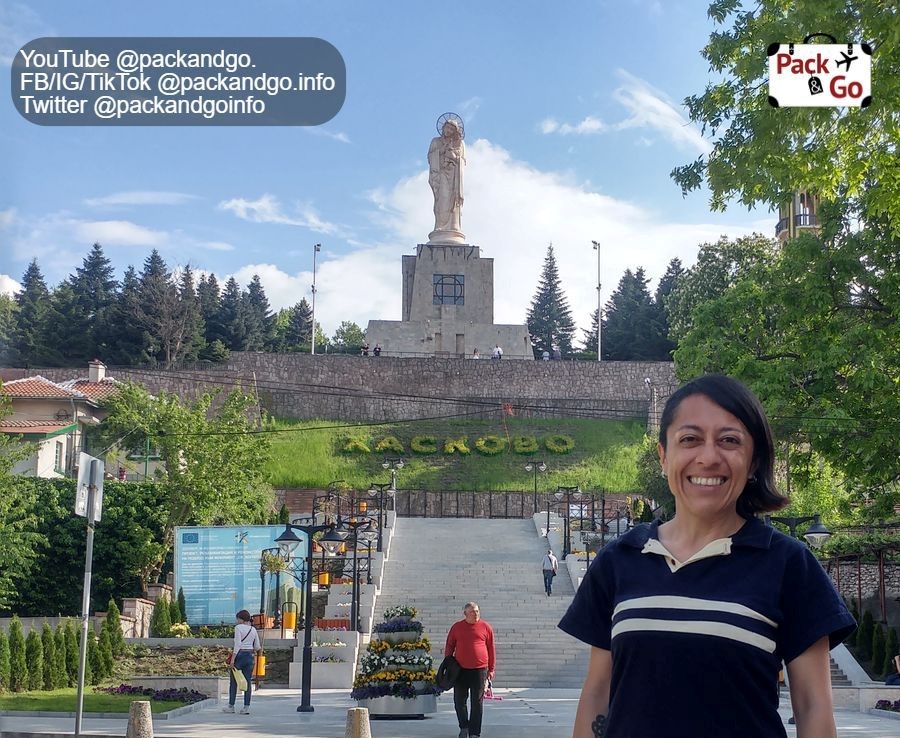
What to do in Haskovo?
There are many things to see in Haskovo. You can easily spend a weekend or even a full week in Haskovo and its surroundings, without getting bored.
Haskovo’s top attractions:
-
The monument of the Virgin Mary
-
Haskovo’s Bell Tower
-
San Stefano Street in Haskovo
-
The Monument of Envy
-
The Regional Historical Museum of Haskovo
-
Old Haskovo Clock Tower
-
1000 years Haskovo monument
-
Kenana Park
See the monument of the Virgin Mary (Monument of the Holy Mother of God)
Haskovo’s statue of the Virgin Mary is so monumental that it holds the Guinness world record for the highest monument of the Virgin Mary in the world. It is 32.8 meters high! What is so great about it is that it is located on a hill, so when you climb on it, you can see the whole Haskovo city.
Inside the statue, there is a small chapel called “Nativity of the Blessed Virgin Mary”. Greek tourists like to put candles inside the chapel.
The Virgin Mary statue is located inside Yamacha Park. There you can spend the whole afternoon, having a nice picnic or just a walk. And just next to the monument of the Virgin Mary, there is the Bell Tower of Haskovo.
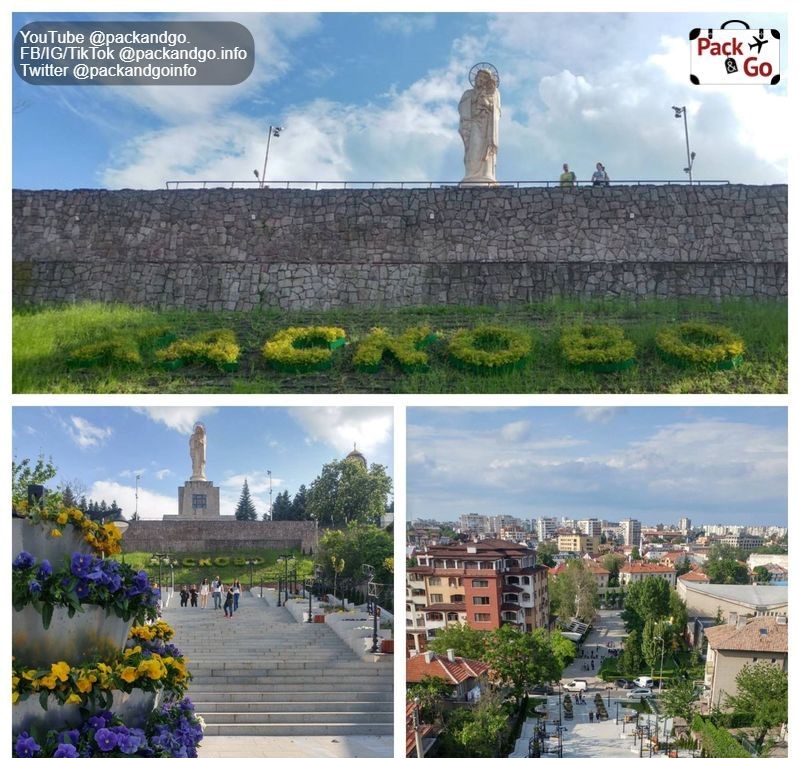
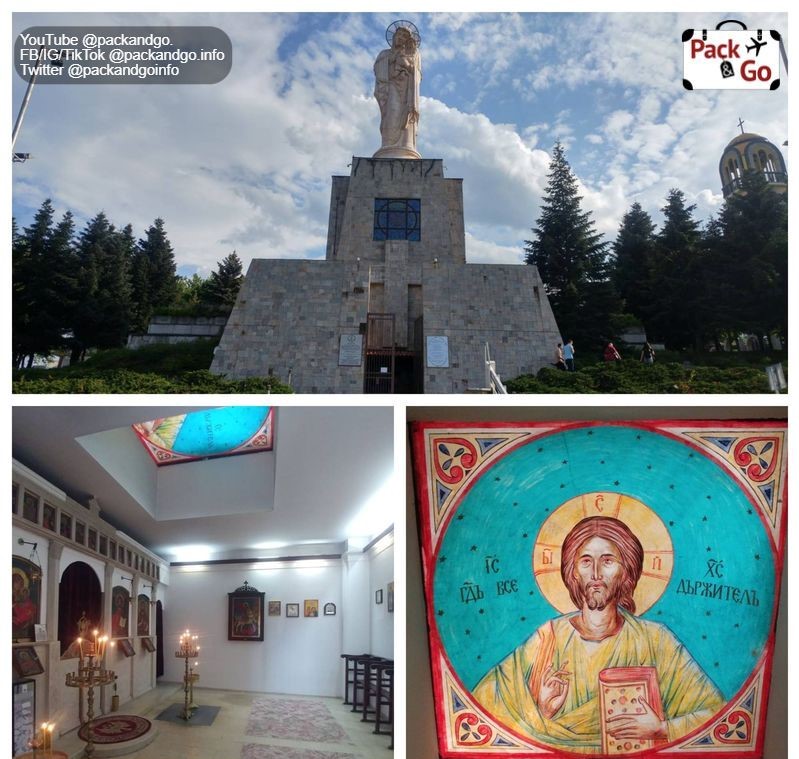
Climb Haskovo’s Bell Tower
Inside Yamacha Park, just next to the Monument of the Holy Mother of God, you will find a beautiful Bell Tower. From the moment we saw it, we wanted to climb it. Of all the things to do in Haskovo, this one is a must. It has the best possible view of Haskovo. But there is a catch. Haskovo Bell Tower is a working clock tower. It rings the bells every hour, and there is nothing to stop you from climbing to the bells. Only a small sign in Bulgarian saying not to climb when it will ring. We arrived 10 minutes before the next ring. This pushed us to climb the tower in a hurry. We managed to do it and have a few photos from the top. Then it was a dash to the ground. Just as we sat on one bench below the Bell Tower started ringing. It has a powerful sound. I was glad we managed to get down on time or we could easily get deaf from the loud sound. Seriously, don’t stay up when it is ringing. It could be very harmful for your ears.
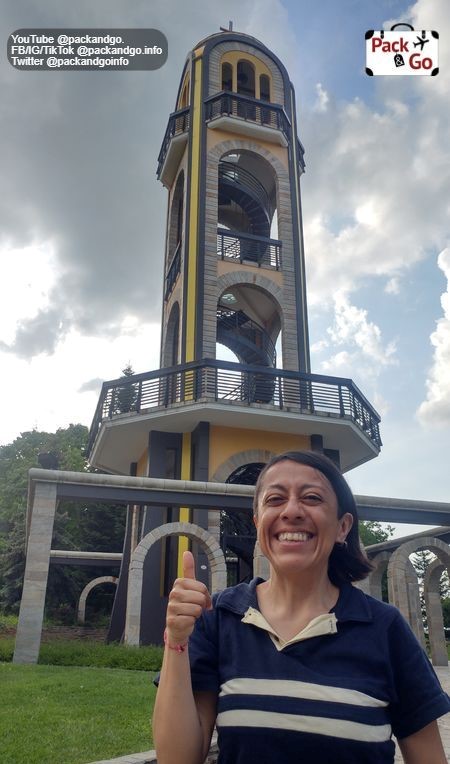
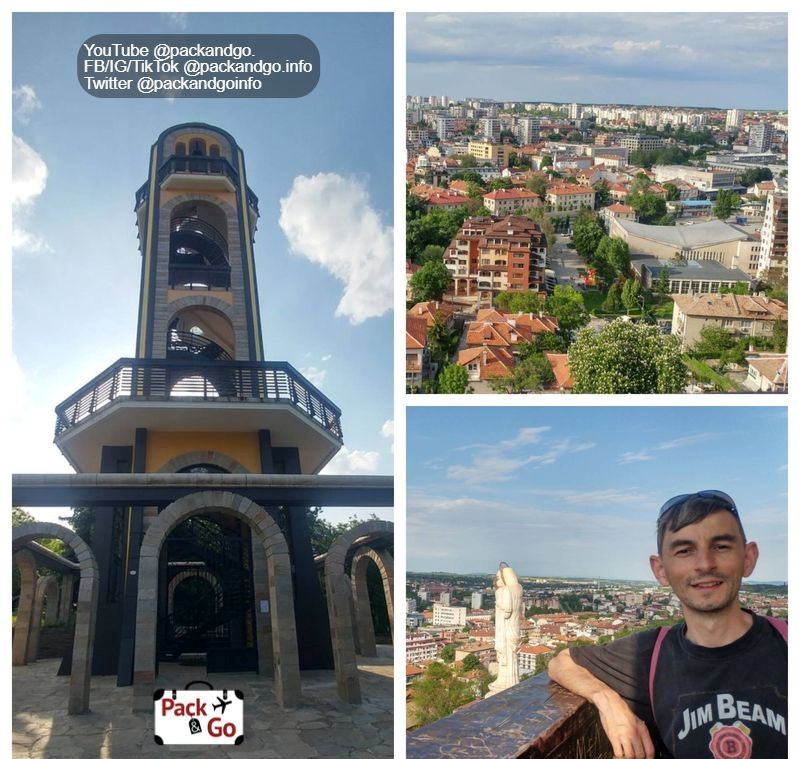
Walk on San Stefano Street towards the downtown of Haskovo
Start from the monument of Kapitan Petko Voyvoda and walk toward Obshtinski Square.
There you can find plenty of coffee places, restaurants, and fast food stands. We enjoyed a lot how lively this part of Haskovo was. You see people of all ages enjoying their time. If you are into Greek gyros or Turkish doner kebab, there are many options on the street.
The walk to the center of Haskovo is short, maybe around 10 minutes, but it is really pleasant. In the end, you will see the start of Obshtinski Square and the Monument of Envy.
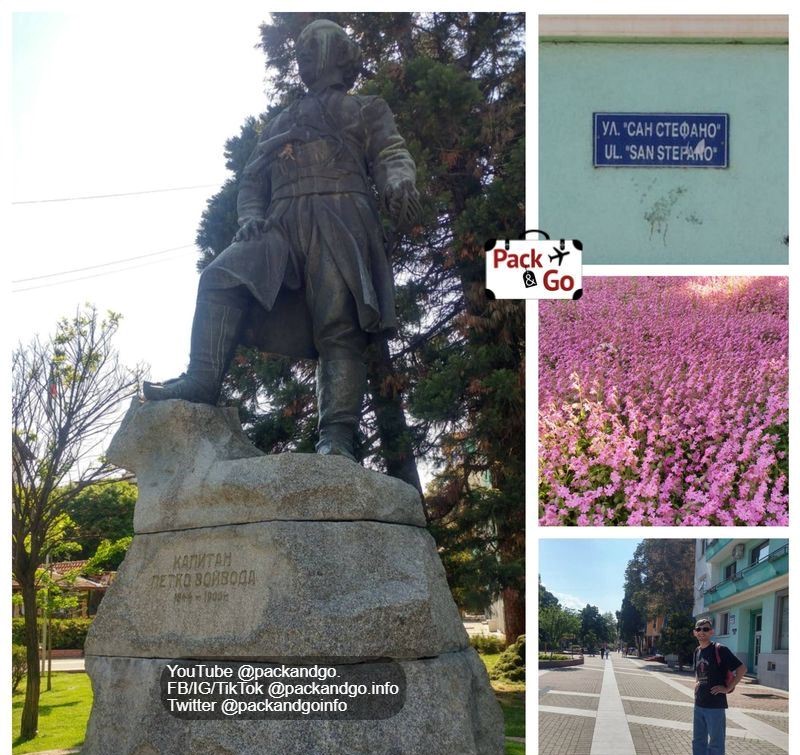
Rest next to the Monument of Envy in Haskovo
The people from Haskovo are really proud of this monument. They say it is the only monument of Envy in the whole world. We can’t guarantee that, but it is not common when somebody creates a monument of a negative feature.
The monument of Envy in Haskovo represents a successful man, that has spread his wings and he is ready to fly high. But there is an ugly, skeleton hand, that drags him down, in an attempt of stopping him. With his sculpture, the author Gospodin Tenev (Guspata), wanted to say that there will always be envious people trying to stop you. And actually, you should embrace it. When the “ugly” people start to bother you, you should know you are on the right path to greatness.
Why should you see it? Because it is truly inspirational. Don’t give up when envious people come into your life. Fly away and resist the negativeness.
We got an ice cream from Billa and had a nice break next to the statue. On a hot day, ice cream and the drops from the fountain were a great combination.
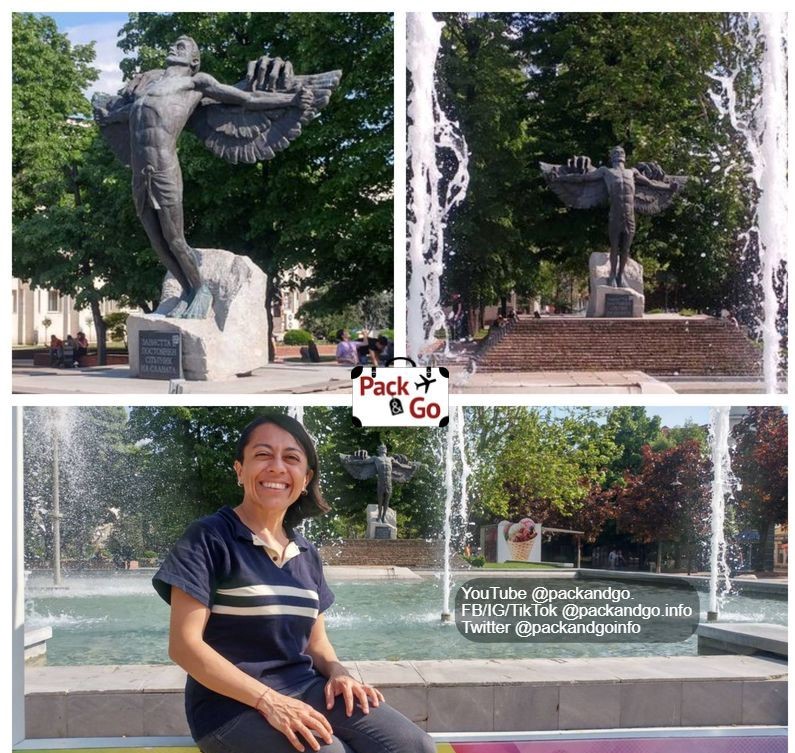
Visit the Regional Historical Museum of Haskovo
If you are into museums visit the Regional Historical Museum of Haskovo. Why? Bulgaria has a rich history dating back to the stone age. What is interesting about Haskovo’s history is that it is located in the geographical area of Thrace. You can find some truly ancient artefacts from the Neolithic age (between 8000 to 5000 years BC!). You can explore history through all the tools that are still well-preserved. Going from stones to primitive metal tools and finishing in the middle ages.
Greek, Turkish, and Bulgarian tourists can enjoy the Regional Historical Museum in Haskovo, and see how these countries and their cultures have been intertwined together for many ages.
The entrance costs 2 BGN (around 1 euro) for adults and half price, 1 BGN for children and pensioners. It is worth it.
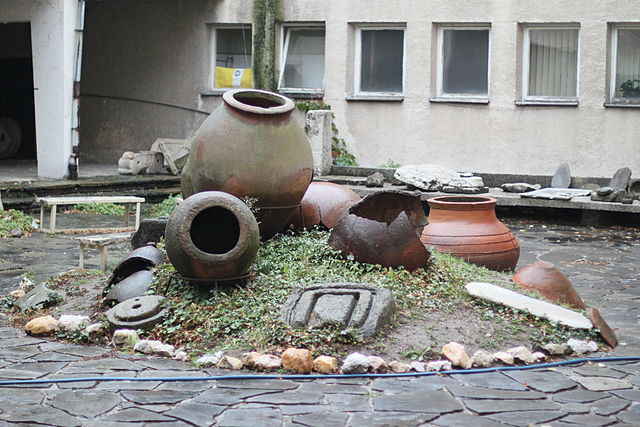
Check out the Old Haskovo Clock Tower
In Haskovo, you don’t need a watch, you can see the time everywhere. The Old Clock Tower of Haskovo was built at the beginning of the 19th century and still shows the time, in the center of the city. It is a 23-meter high Clock Tower, with a recently updated mechanism and the bell, created by the same company that built the Big Ben bell in London.

Eat Bulgarian food
We can’t just walk all day without getting hungry! Enjoy some traditional Bulgarian food in Haskovo. Here, you can enjoy a great fusion between Bulgarian, Turkish, and Greek cousins. You will find Pide, Musaka, different kebabs, Lahmacun, Kiopoolu, Banitza, filled paprikas with minced meat and rice, sarma, and more. Just writing these incredible foods makes me hungry.
Of course, there are pizzas and burgers, just like anywhere in the world, but Haskovo has great local food too. Try it out! Broaden your culinary culture!
| Follow PackAndGo.info at: | |
| YouTube | @packandgo. |
| @packandgo.info | |
| X | @packandgoinfo |
| @packandgo.info | |
| Bluesky | @packandgo.bsky.social |
| TikTok | @packandgo.info |
Check out the 1000 years Haskovo monument
While you are in the center of Haskovo, take pictures of the 1000 years of Haskovo monument. Here in this city, people love clock towers, so you can enjoy one more. It is a high building, 26.5 meters and it has a very cool design. It looks heavy, industrial and somehow reminds me of the Transformers.
The idea of the monument was to show the 4 directions of the world and to represent that Haskovo is on the way between the East (Asia), and West (Europe).
Sadly, tourists can’t climb on it.
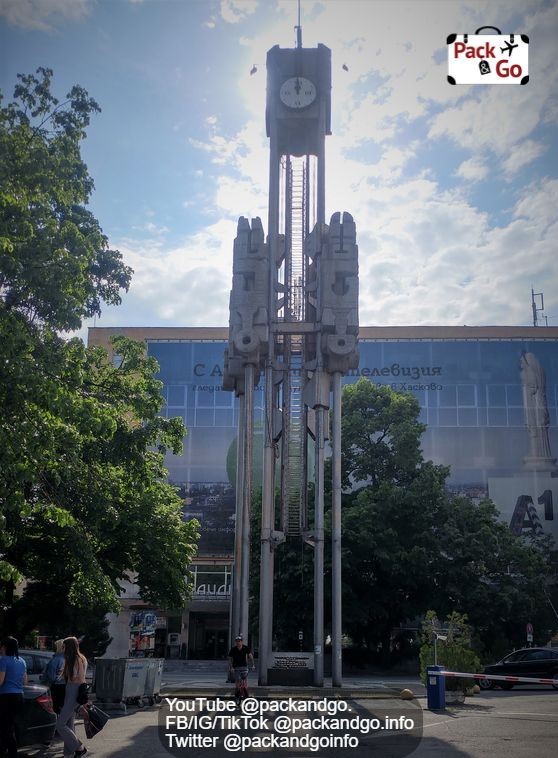
Park Kenana (Lesnopark Kenana) and Haskovo Zoo (Kenana Park Zoo)
Do you fill like going into the forest? Lesopark Kenana gives you a great opportunity to do it. It is big and perfect for a walk with your family or pet. Kenana Park is both pet-friendly and kid-friendly. It is your escape from the city. It is located in the north part of Haskovo. You can easily arrive by car or public transport.
We saw many people that come to do their exercises here. Runners, cyclists, tennis players, yoga people and more.
In this forest environment, there is a small zoo too, the Kenana Park Zoo. With animals, typical for the Balkan forest like deer, rabbits, ducks, wolves, and more. The big exception is the lions. They look a bit out of place here, but the locals love them.
Bear in mind that there are no businesses inside the park. You need to prepare yourself with food and drinks.
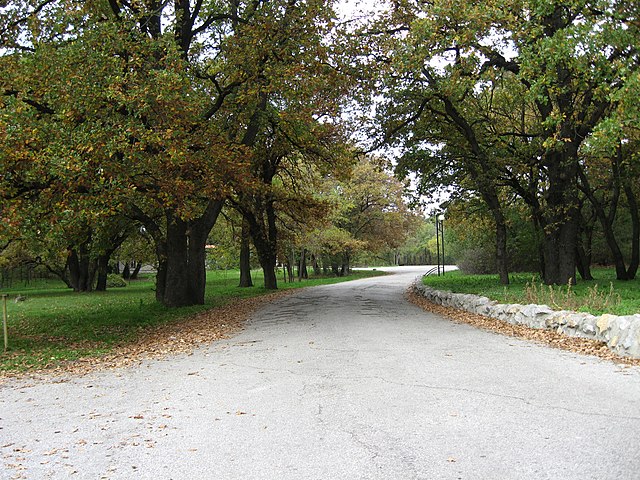
What to visit near Haskovo?
There are a few truly interesting places you can visit near Haskovo. Some will help you discover more about the history of the region, and others, will just feel your heart with joy from the nature’s beauty.
Top attractions in Haskovo’s surroundings:
- Historical museum Dimitrovgrad
- Thracian tomb of Aleksandrovo
- The Stone Mushrooms
- Perperikon (Perperek)
Historical museum Dimitorvgrad - 14 km away
You should visit it because you can learn more about the socialist past of Bulgaria. “Brigadier Movement in Bulgaria" hall focuses exactly on this period. You will see old uniforms, flags, different signs, photos, and awards from the Brigadiers' past.
The entrance is just 2 BGN for adults and half price (1 BGN) for children and pensioners.
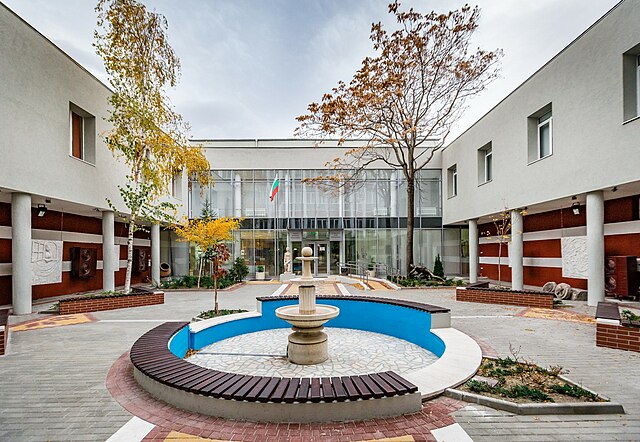
Alexandrovo Tomb (Thracian tomb of Aleksandrovo) – 16 km away
The Alexandrovo Tomb is an ancient Thracian tomb from the 4th century BC. The name of the ruler, resting in it remains a mystery. This is why some people speculate that it is the grave of Alexander the Great. He also died during the 4th century BC, and Macedonia is close. There are some chances this myth is true.
Even if the Tomb in Alexandrovo is not Alexander the Great’s tomb, you can still see some really unique artefacts like the Thracian frescos and amazing tomb architecture. A funny fact is that in one of the frescos, one participant in a hunt wears Greek sandals. This obviously shows how strong the Greek influence was in this region.
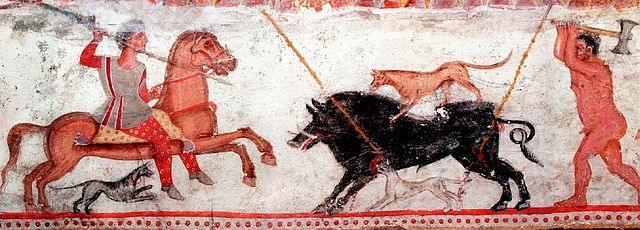
The Stone Mushrooms (Mushroom rocks) – 20 km away
The Stone Mushrooms is a unique rock phenomenon near the village of Beli Plast, between Haskovo and Kardzali. On our way to Kardzali, we stopped to check it out. The stones have a very extravagant form, that strongly resembles mushrooms. This is why they are called the Stone Mushrooms.
They are created from volcanic tuffs (learn about volcanos) rocks and have cool colors like pink (mineral cloinoptilolite), blue and black spots from manganese, and even green colors from the mineral celadonite.
Each stone mushroom is around 2.5 to 3 meters high, and there are more than several rocks around.
If you are into cool rock formations, you can also check Belogradchik, or Sliven, and its blue rocks.
There is no entrance fee for the Stone Mushrooms near Haskovo. They are free to visit.
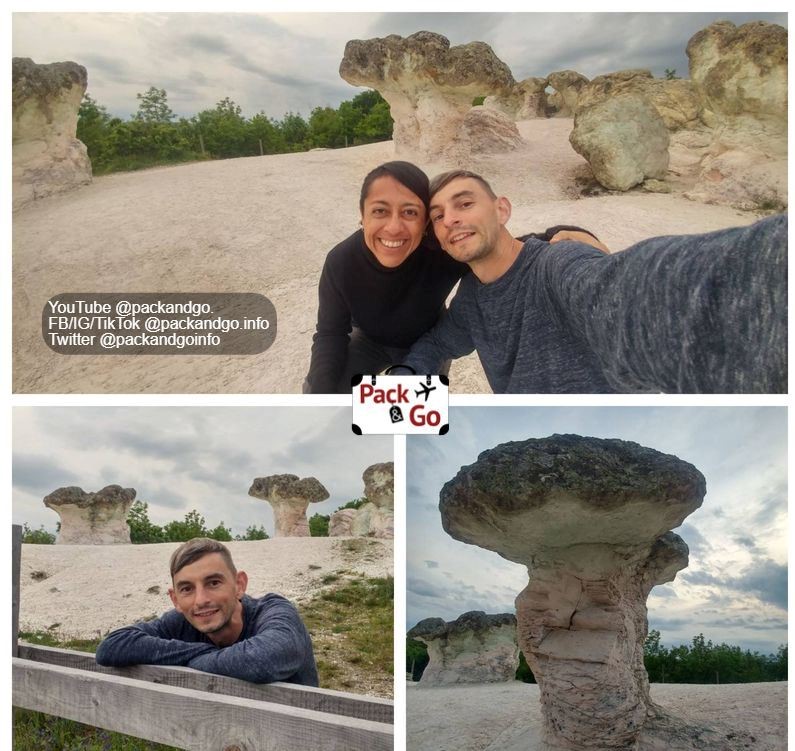
Perperikon (Perperek) – 25 km away
Peperikon is another must-see landmark in Bulgaria. It is a Thracian holy place from 6 000 years BC! An ancient place! Currently, there are remains from the last middle age settlement there and a beautiful stone tower.
Thousands of tourists come to Perperikon, not only from Turkiye and Greece but also from all over the world.
Honestly, you can reach it from Haskovo easily, but it is just a bit closer to Kardzali. So if you want to know more about it, check out our Kadzali article (LINK).
Outro
So, what are you waiting for? You saw the pictures from Haskovo already.
If you are in Edirne, it is closer to come here than to go to Istanbul. It will be a whole new country with a different language and culture.
For Greeks, there are also many things to see in Haskovo. Greece is old, but Thrace has a lot of history too.
There are plenty of things to do in Haskovo. Just visit Haskovo already!
How to get to Haskovo?
From Turkey to Haskovo:
The distance between Edirne and Haskovo is just 100 km and it takes only hour and a half to get there. Check the navigation here.
The distance between Tekirdag and Haskovo is 250 km and it takes 3 hours to get there. Check the navigation here.
The distance between Istanbul and Haskovo is 345 km and it takes 4 hours to get there. Check the navigation here.
Turkish citizens must obtain a Bulgarian visa, before their trip. The process is not hard and it gives you the right to stay up to 90 days in Bulgaria. You can get a visa at the Bulgarian consulates or embassies in the following cities: Ankara, Bursa, Edirne, and Istanbul.
Check out how to get a Bulgarian visa here (LINK).
From Greece to Haskovo:
The distance between Komotini and Haskovo is just 118 km and it only takes 1 hour and 52 minutes to get there. Check the navigation here.
The distance between Alexandroupoli and Haskovo is 172 km and it takes 2 hours and a half to get there. Check the navigation here.
The distance between Kavala and Haskovo is 215 km and it takes 2 hours and 50 minutes to get there. Check the navigation here.
Greek people only need their ID cards or passports to cross.
For tourists within Bulgaria:
And of course, you can get easily get to Haskovo from different Bulgarian cities:
The distance between Kardzali and Haskovo is just 47 km and it takes only 45 minutes to get there. Check the navigation here
The distance between Stara Zagora and Haskovo is just 60 km and it takes only ah hour to get there. Check the navigation here
The distance between Plovdiv and Haskovo is 96.4 km and it takes 1 hour and 10 minutes to get there. Check the navigation here
The distance between Sliven and Haskovo is 136 km and it takes 1 hour and 40 minutes to get there. Check the navigation here!
| Follow PackAndGo.info at: | |
| YouTube | @packandgo. |
| @packandgo.info | |
| X | @packandgoinfo |
| @packandgo.info | |
| Bluesky | @packandgo.bsky.social |
| TikTok | @packandgo.info |
- Details
- Written by: Gianna Esquivel
- Hits: 934
Another long Winter in Europe is over, yeeii! And, for us, that means time to travel! To start our 2023 traveling season, we picked beautiful Greece! We checked Google Maps to calculate the distance between our starting point and the first Greek city on our way and it said 8 hours drive. We laughed because Google’s time does not match PackAndGo’s time. We barely travel straightforwardly to a point. We prefer to stop every time we see something interesting on the map. So, we knew this drive would take us much longer, weeks maybe haha, and that sounded great for us!
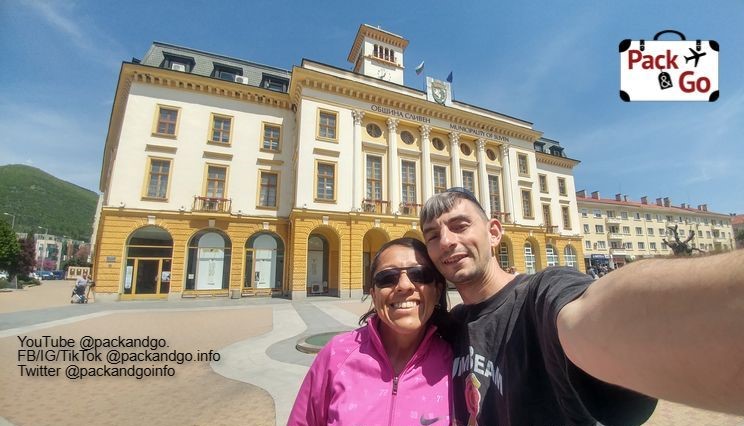
So we left home and the first stop of this new adventure was Sliven, Bulgaria, and its surroundings. Why nobody visits Sliven? What to see in Sliven? Was it good or not? Is it worth visiting it or you should better skip it? Find it out here!
Where is Sliven (Сливен)?
If you see a map of Bulgaria and take the capital Sofia as a reference, you will find Sliven on the east, 300 km away. It is 110 km away from Burgas, 110 km from the border with Turkey (Lesovo-Hamzabeyli), and 150 km approximately, from the border with Greece (Kapitan Petko Voyvoda-Ormenio). Based on those similar distances, this Bulgarian city looks very centric, so why nobody visits Sliven?
What is Sliven famous for?
While searching for what to do in Sliven, we discovered it is famous for its deep history and natural beauty. It is also known as the "City of a Hundred Voivodes" and the "City of the Blue Stones”.
The name "City of a Hundred Voivodes" has a historical origin. “Voyvoda” (Old Slavic) was an exclusive title reserved solely for brave military warlords or leaders in Bulgarian history. In the 19th century, during Ottoman rule, Sliven was an important spot of revolutionary activity. It was a center of the haiduk movement, a popular form of resistance against Turkish occupation. Commonly, haiduk bands or groups were integrated by one hundred men each and a leader. Many renowned freedom fighters, and defenders of the national identity, with the "Voyvoda" title, were from Sliven or operated in its region. This is how Sliven earned its reputation as the "City of a Hundred Voivodes". It sounds epic, right?
Famous voivodes (voyvodi, in Old Slavic) and revolutionaries from Sliven:
-
Hadzhi Dimitar
-
Panayot Hitov
-
Georgi Rakovski
-
Indzhe Voyvoda
-
Zlati
-
Kara Sabi
-
Filip Totyo
-
Stefan Karadzha
-
Tanyu Voyvoda
-
And many more.
The name “City of the Blue Stones” has its origin in the natural landmarks that beautifully frame the city. The Blue Stones or Sinite Kamani (Сините камъни) is a range of striking cliffs and rock formations located in the eastern part of the Balkan Mountains. These rocks feature different blue and green tonalities that together create a mesmerizing and unique view. The green color is not strange considering the vast flora of the whole region, but the blue one is created due to the presence of a mineral called vivianite. These natural formations have become deeply associated with Sliven’s identity.
By the way, if you like amazing rock formations you could also enjoy reading about Belogradchik Rocks near Vidin, Bulgaria.
As you see, Sliven’s past was epic, synonymous with bravery, warfare, and awesome nature. Is Sliven’s present as impressive as before? Or did everything die just like the voivodes?
What to visit in Sliven?
The location of today's city has been inhabited for millennia. Sliven’s history goes back to the Thracian’s time and from there, you can walk through different history layers involving Romans, Slavs, Greeks, and the First and Second Bulgarian Empires.
Besides, here, the first Bulgarian factory was established in 1834, by Dobri Zhelyazkov. This marked the beginning of industrial development in Bulgaria. Sliven has a long-standing tradition in the textile, machinery, glass, electrical engineering, and food industries. This means, if you are into history and museums, there are many you can visit in Sliven.
List of the best museums in Sliven:
-
Regional historical museum, "Dr. Simeon Tabakov".
-
Museum of the textile industry.
-
Hadji Dimitar House-Museum.
-
Dobri Chintulov House Museum.
-
House-museum of the Old Sliven Popular Customs.
Ok, and besides museums, what to visit in Sliven? Well, these are the places we liked the most.
The monument of Hadji Dimitar
This national hero was born in Sliven. The monument is located in the heart of the city. The figure of the voivode is about 4 meters high and the whole monument is 12 meters high. Locals have the tradition to offer flowers in this monument on city holidays or weddings.
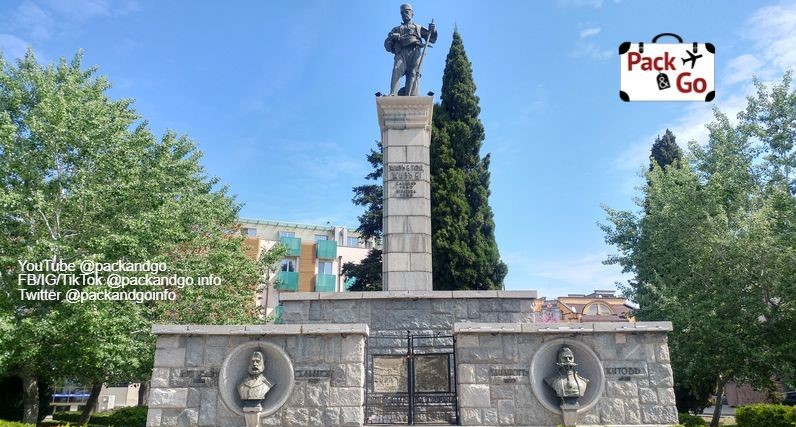
Why did we enjoy a monument? Well, since the beginning we read about the famous voivodes of Sliven. It was nice to find a very famous one (his monument) just a few streets away from our accommodation hahaha. Besides, the monument is located in a very pleasant space with benches where you can stop and have a cool break. A simple pleasure? Yes! We liked it and we took some minutes here to check the map and choose our next stop: Sliven market.
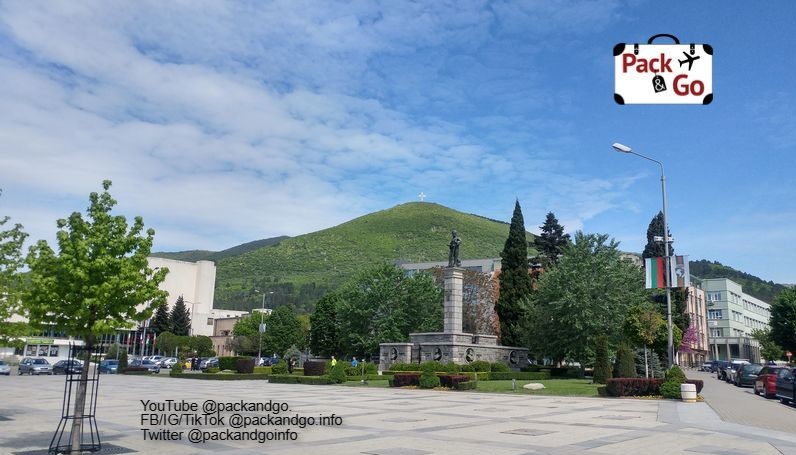
Sliven market
We like to visit markets because they are a cool experience for the senses. All those aromas and colors of fresh fruits, herbs, and species hit your nose and eyes in such a way! Then you buy and your touch and taste get thrilled. This time, M discovered very nice stuff, some delicious spices! Samardala (самардала) and Trahana (трахана).
What is Samardala (самардала)?
Samardala (самардала) or Bulgarian honey garlic in English, a traditional Bulgarian spice mix that we haven’t seen before. Samardala is a herbaceous plant, endemic to the Balkan Peninsula that people dry, crush and combine with salt. It has a very attractive and intense green color and a garlic aroma. It seems to be very popular for cooking especially in the region of Strandja, Sliven, Stara Zagora, and Kazanlak.
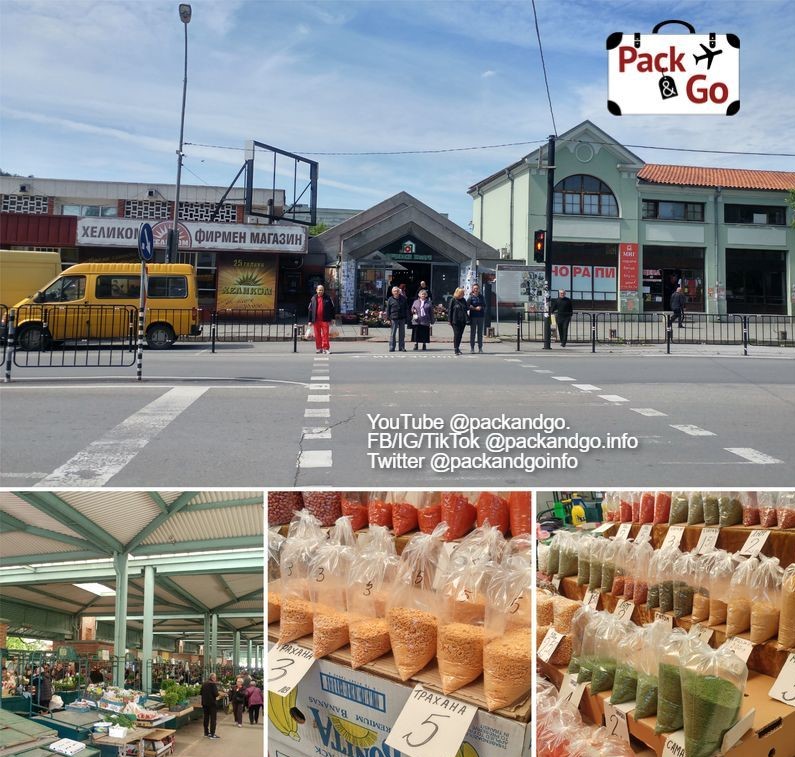
What is Trahana (трахана)?
Trahana (трахана) is a spice mix from the Arabic countries. It is a mixture of flour with vegetables such as pepper, tomato, carrot, celery, and chickpea. Vegetables are boiled, ground, mixed with flour, yeast, and left to ferment. Once ready, it gets dried, and crushed until it becomes an aromatic, orange powder. It is very used in many Balkan countries and the Middle East.
We bought both and we are dying to cook with them! So, Sliven market can surprise you! Give it a shot!
The clock tower
We kept walking until we reached the center and there, the clock tower is. This landmark is more than 200 years old. In the past, it was used as an observation post for firefighters. It also had a bell. When the new clock tower was built in Sliven, the clock mechanism and the bell were moved there.
The Old Elm
Sliven hosts a tree that is more than 1,300 years old. It has become another symbol of the city. The Old Elm is in the center of Sliven, nearby the municipality. There, we read that in 2013 there was a national competition called “Tree with Root” and this tree was the winner. It was also awarded the “European Tree of the Year 2014”.

Sliven’s municipality
Sliven’s municipality building is a big one, old-style, and well-preserved. It is impossible not to see it while exploring the center. Around the municipality there are benches and the street is very wide so people gather for multiple purposes. You can simply have a break there and enjoy people-watching. We got hungry so we decided to stay there for eating a very tasty "lodka" bread.
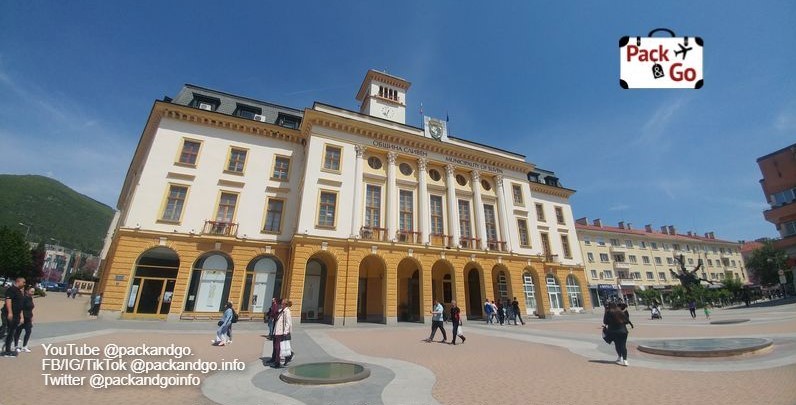
The vibe of Sliven, contrary to what you can expect of an industrial city, was calm and nice. The center has restaurants, coffee and souvenir shops, landmarks, and places to visit. So we wondered again why nobody visits Sliven.
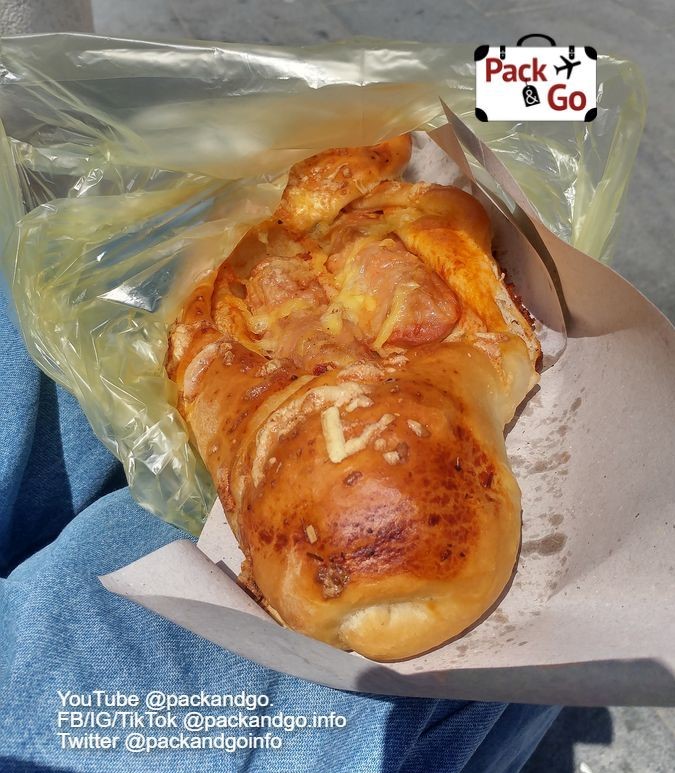
Regional historical museum, "Dr. Simeon Tabakov"
With the happy belly after that "lodka" bread, we felt ready for a museum. If you want to go deep in the history of Sliven and the whole region this is the place. There is a Thracian gold mask from the 4th century BC, many gold ornaments, a seal of Prince Boris, a torso of the God Asclepius, glass vials used to collect the tears of professional mourners, women’s leather shoes from the Roman times, vestiges of the Tuida fortress, etc.
Tuida fortress
You will find the Tuida fortress on the Hisarlaka hill, in the northeastern part of the city. The fortress is located at the foot of the Blue Stones and was used for centuries, during the Roman Empire, Byzantium, and medieval Bulgaria. From the north part of the fortress, you can see the cliffs of the Sliven Blue Stones Natural Park. From the south, you will have a view of the lower neighborhoods of Sliven.
From the 5th to the 15th centuries, Hisarlaka Fortress was the administrative and religious center of the region. The fortress was built over ten centuries by different rulers. During your visit, you can see the walls, gates, towers, and remains of Tuida’s buildings, two pedestals made of marble dedicated to the gods Zeus and Apollo, and more.
Museum of the textile industry
What? Another museum? Hahaha Honestly, we prefer outdoor spaces but ok, the textile industry is a big thing for Sliven and we could learn something. So yes, we got into this museum and walked through centuries of development of the textile industry, some interesting machines, and demonstrations. Can you believe that in the 7th century BC, already existed a loom which weaved one meter of fabric in only 5 hours? What about a loom whose technology contributed to the creation of the first computer? It is a loom created by Joseph Marie Jacquard, in 1804. It weaved fabrics with intricate patterns using punched cards. Later on, Charles Babbage borrowed the idea to create the first computer. Interesting, doesn’t it?
Other places you can visit in Sliven.
We did not visit the following spots, so if you go, tell us your opinion, please! And if you visit other voyvods’ houses (museums) or something else we missed, your recommendations are welcome!
| Follow PackAndGo.info at: | |
| YouTube | @packandgo. |
| @packandgo.info | |
| X | @packandgoinfo |
| @packandgo.info | |
| Bluesky | @packandgo.bsky.social |
| TikTok | @packandgo.info |
House-museum of the Old Sliven Popular Customs
It is a Revival Sliven house from the beginning of the 19th century, that hosts an ethnographic exhibition.
Hadji Dimitar House-Museum
It is hosted by the father’s inn of the national hero. His native house is next door and was built by his grandfather in the late 18th century.
Factory of Dobri Zhelyazkov
Part of the factory established by Zhelyazkov in 1834 has been preserved. As we mentioned before, this factory meant a lot for the industrial development of the region and Bulgaria, in general.
What to visit around Sliven?
Karandila (Карандила)
Without a doubt, this is a place you should not miss! It is within the Blue Stones Natural Park (Сините камъни), a beautiful area full of valleys, natural springs, waterfalls, cliffs, stones, and fresh air. You can get a great view from every corner!
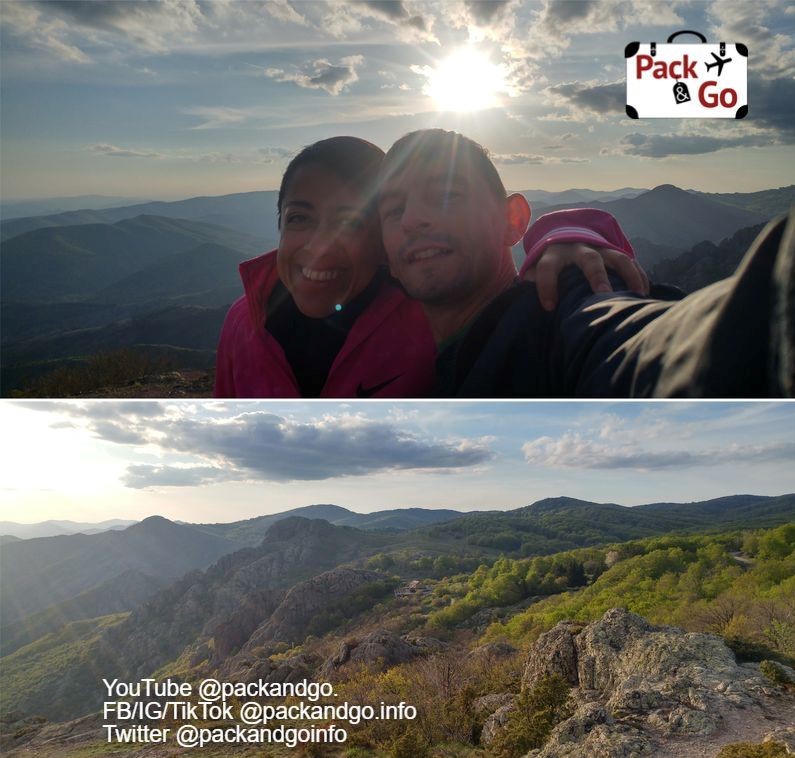
Karandila is one of the biggest attractions within the Natural Park. It is a hilltop located 1,050 m above sea level and the sights from there are a-we-so-me! There is a famous rock formation in Karandila called Halkata (Халката, meaning the ring). As the name suggests, it is a rock protrusion with a hole in the center. And there is a myth that says, you should be granted your most sincere wish if you pass through the ring. Of course, we do not believe in myths, but we wished and passed through the ring, just in case! Don’t judge us! Hahaha. You can explore or just choose a rock to sit on and enjoy your favorite view. It is a place we enjoyed a lot!
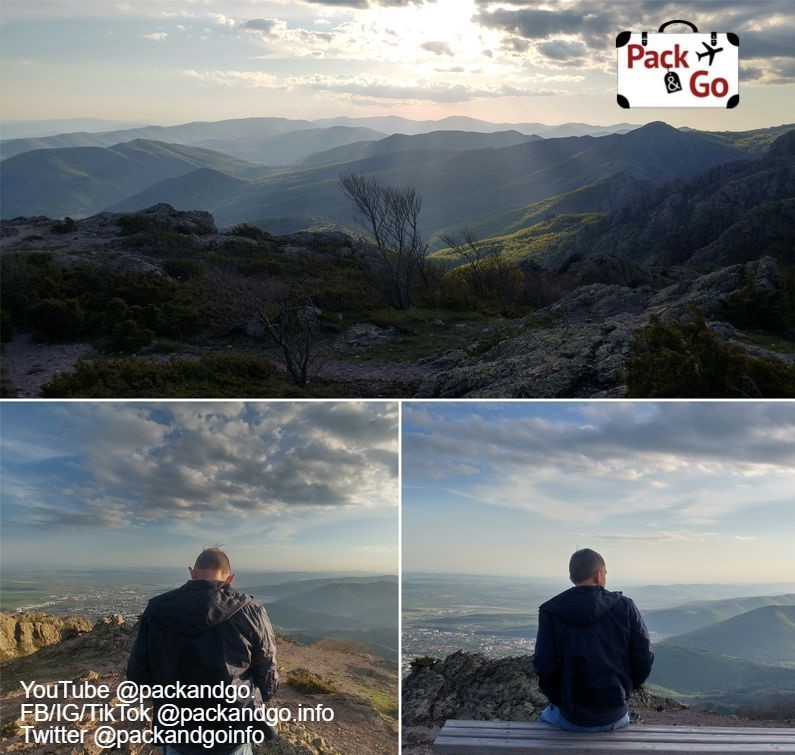
You can look for different hiking choices because the Blue Stones Natural Park is large. Easier or harder ones, you decide. One very common hiking goal is to reach Halkata.
Karandila lift or cable line (Пътническа въжена линия „Сливен – Карандила“)
There is another way for you to enjoy the amazing views of the Blue Stones. A lift or cable line is operating in the area, so without physical effort, you can have 20 minutes of really nice natural views and fresh air, while “flying” on a chair over the beautiful Blue Stones Natural Park near Sliven. The information on the Internet is in Bulgarian, but we will share the essential details with you now.

It is not open during the whole year. This 2023, it started operations on June the 8th.
Working hours: from 8.30 a.m. to 4.30 p.m. Last boarding at 4.00 p.m. (one way). The schedule varies according to the season. During Summer, the cable line operates until 5:30 p.m., with the last ascent at 5:00 p.m.
Monday: from noon.
Length along the slope: 1,895 m.
Elevation: 597 m. Lower station altitude - 390 m. Upper station altitude - 987 m.
Speed: 1.6 m/s.
Travel duration: 20 minutes.
Starting point to the lower cable line station: Kapatazh locality
From the information center of the "Blue Stones" Nature Park - 10 minutes.
From the city of Sliven - by urban bus or on foot.
Starting point from the upper cable car station: Slancheva Polyana locality
From Karandila Hut and Karandila Hotel (tourist house) - 30 minutes.
Prices (2023): One-way, BGN 10.00 (€5). Two-way: BGN 15.00 (€7.68). Children under 7 years old travel for free with an accompanying adult.
Kotel Old Town
Approximately 65 km northeast of Sliven, located in the middle foothills of the Eastern Stara Planina (Стара Планина), in the flat part of a mountain valley and Demir Kapia (an important geographically historical pass which witnessed many battles), you find Kotel (Котел).
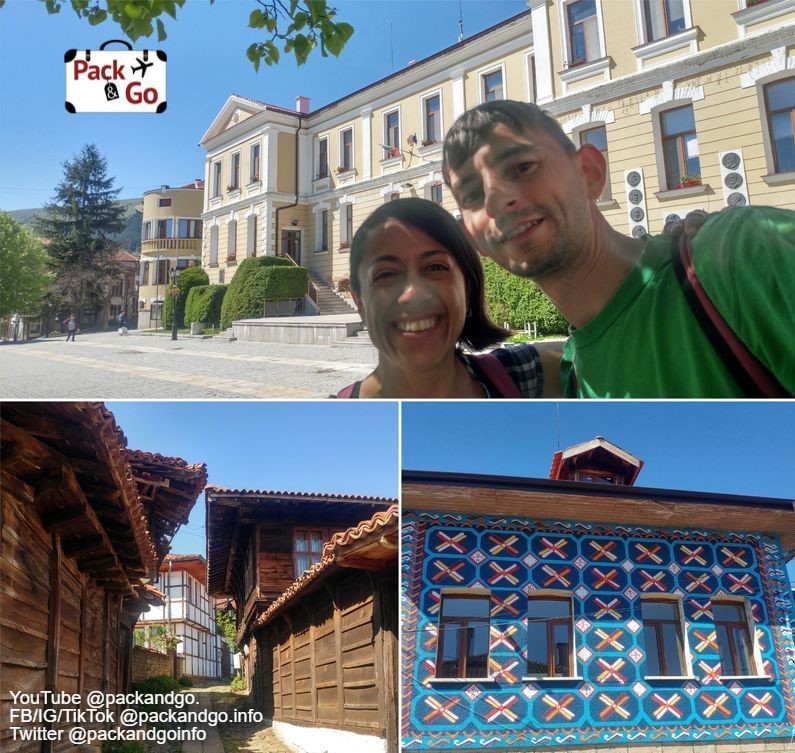
Our objective was to visit the Old Town, located on the outskirts of this mountain town. The place is an icon of the Liberation movement of the 19th century and the Bulgarian Revival period (18th and 19th centuries). What is interesting is the architecture of the houses. You walk in meandering, narrow stone-paved streets while seeing preserved and restored wood-covered houses from the Revival period. Some of the old public buildings and houses have become museums, shops, restaurants, coffee shops, or guest houses. And many of them are just normal houses that have been restored following the same old style of the area. So it is a very alive ethnographic complex! It is not a recreation, normal people live there and do their daily activities surrounded by curious tourists like us hahaha. After walking around, we stopped to get a coffee and a beer in the quiet, clean, and cute center, to keep enjoying this sort of gap between two dimensions, two very different times!
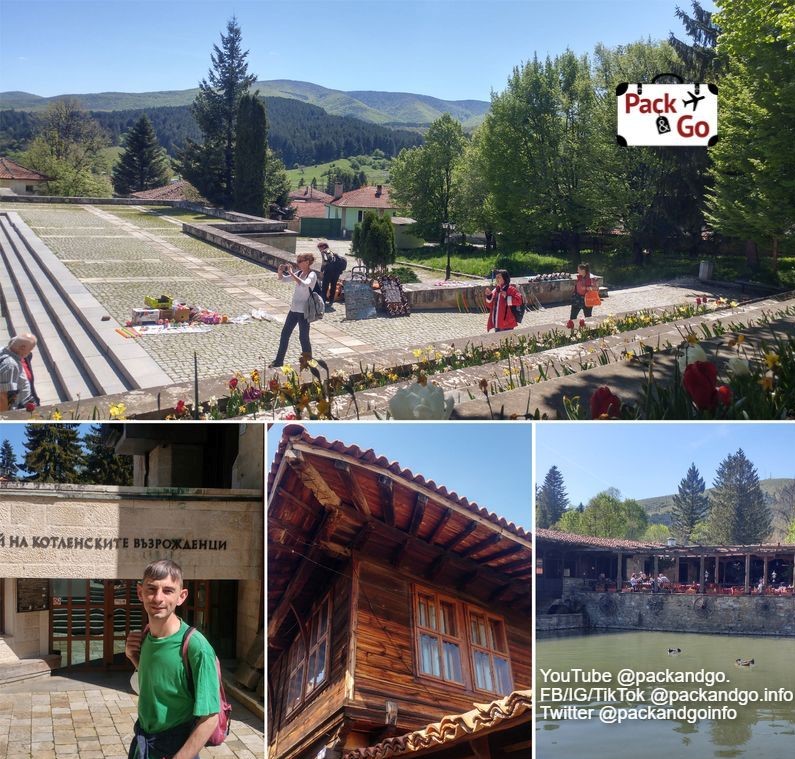
If you get in love with this place, the good news is there are houses on sale. Yes, you can live there if you buy a house.
By the way, if you are heading north-west, you can go and check out Dryanovo. It is a really cool little town.
Zheravna
Zheravna (Жеравна) is a village located only 15 km (south) away from Kotel. It offers you another architectural sample of approximately, 200 wooden houses from the Bulgarian National Revival period. Commonly, they are two-story wooden houses bordered by heavy stone walls. The cobblestone alleys you walk in are nice and lead you to popular sights like the church of St. Nicholas opened in 1834, the museum houses of Rusi Chorbadzhi, a known merchant in the 18th century, and Yordan Yovkov, a respected writer born in 1880.
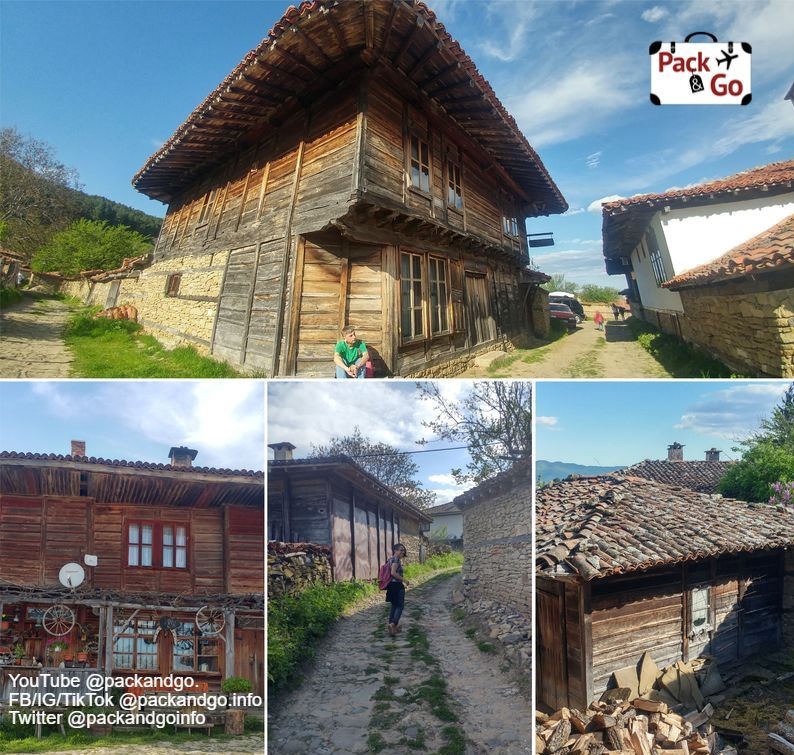
Why nobody visits Sliven?
Now you know the things to do in Sliven and its surroundings. Why nobody visits Sliven? Because Sliven attractions are good, but not “impressive”. As tourists, we all look for different things to enjoy. Most of the people who only have a free weekend or several days to travel, look only for impressive things to visit. Otherwise, they feel it’s not worth it. In our opinion, that is why Sliven does not appear as a top Bulgarian destination.
Do we recommend visiting Sliven, Bulgaria?
Yes, we do! Sliven offers you a relaxing and nice vibe. Its center is a good example of that. It can be a good choice for digital nomads, families or couples to spend a relaxing weekend. Sliven has all the necessary amenities you expect from a city, accommodation, restaurants, cafes, bars, art galleries, supermarkets, tourist attractions, etc. The nature around the city is a big plus and the mean to balance your holidays. Yes, you can enjoy the comfort of a city and combine it with a more challenging adventure exploring the Blue Stones Natural Park. This is exactly what we did. If such a plan suits you, go ahead, just pack and go!
Young and more adventurous travelers directly go to the Blue Stones Natural Park. That is fine! But if Sliven is on your way and you have time for enjoying simple pleasures, give it a shot! We did it! And it was a nice experience.
Based on the season you visit Sliven, you also can find film, music, or folk dance festivals, concerts, art exhibitions, medieval events, the gathering of Karakachans (traditional nomadic shepherds), and more.
Extra note: treat yourself to visiting one of the many bakeries in Sliven. They have very tasty specialties, like those delicious "lodka" we ate! There is one “crocodile” we also liked! They have some bread we have not seen in the Northern cities of Bulgaria.
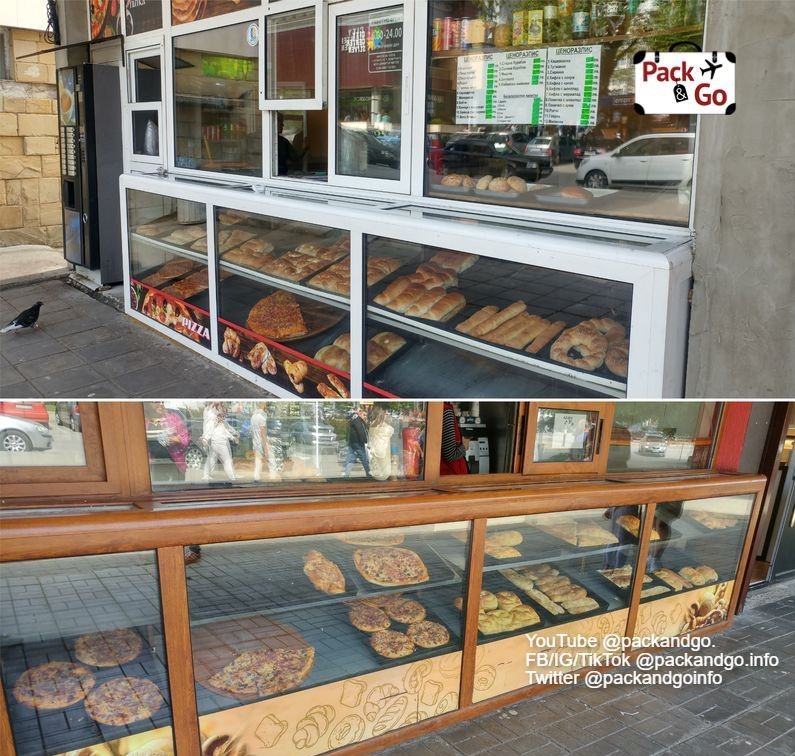
How long should you stay in Sliven?
Honestly, you can spend here as much time as you prefer. You can stay a day or a weekend exploring the attractions within the city. You can plan a longer stay if you visit the cool surroundings. Sliven can be a comfortable base to further exploration of the region that is rich in nature.
| Follow PackAndGo.info at: | |
| YouTube | @packandgo. |
| @packandgo.info | |
| X | @packandgoinfo |
| @packandgo.info | |
| Bluesky | @packandgo.bsky.social |
| TikTok | @packandgo.info |
Conclusion
Sliven and its surroundings were a great beginning for our new 2023 adventure. Greece, our goal, is still far. Follow us and let’s discover together the next stop!
- Details
- Written by: Martin Pramatarov
- Hits: 1157
Ok, so almost everybody who visits Mexico City goes to Alameda or Chapultepec. But Mexico City has a lot more parks to offer. Let’s explore the 3 great hidden parks in Mexico City, no expats know. They don’t get the attention they deserve.
Hidden parks in Mexico City, no expat knows are:
-
Parque Bicentenario (Bicentenario park).
-
Bosque de San Juan de Aragón Park (Aragón Park).
-
Parque Tezozomoc (Tezozomoc park).
Bicentenario Park (Parque Bicentenario)
Less famous, but still amazing is Bicentenario Park. It is located further away from most of the attractions in Mexico City near the metro station Refinería (Line 7) in the industrial zone. What it can brag about are its big size, a beautiful artificial lake, and a botanical garden. Yes, there is a really nice botanic garden in Bicentenario Park!
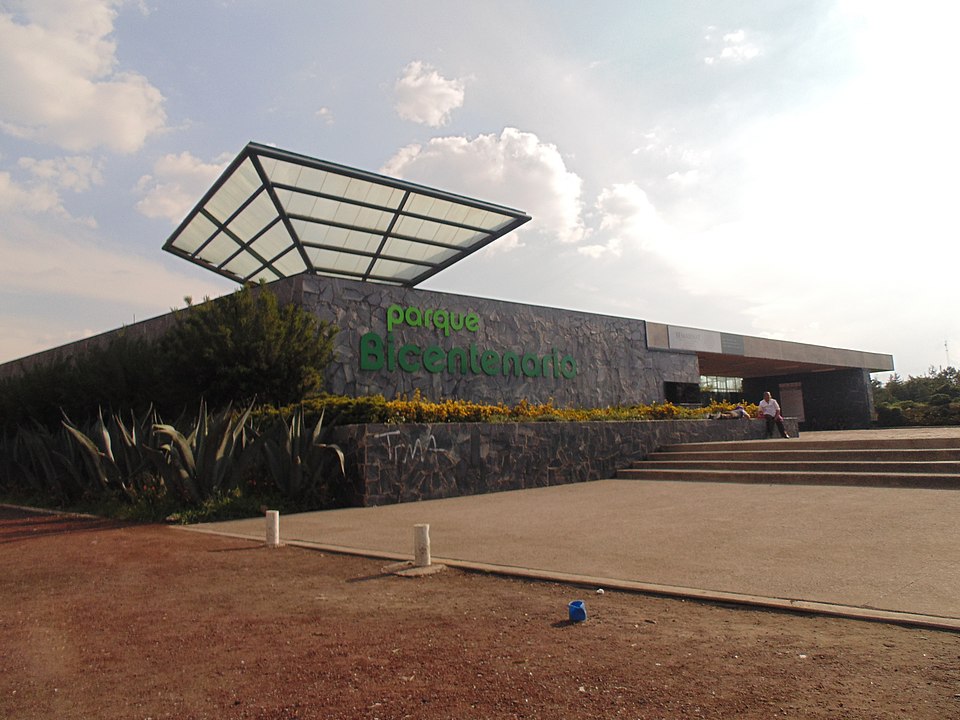
It is a very nice park for daybreak or a picnic. Ok, maybe it is not really a hidden park, but you can rarely see an expat here. I have been working from this Mexico City park many times, and I have barely seen any foreigners.
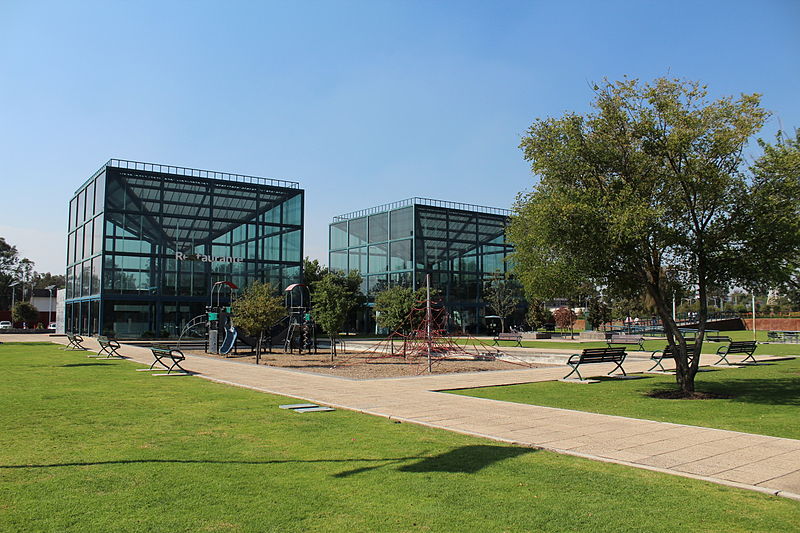
We were living very close to line 7 of the CDMX metro, so it was really easy to visit. For foreigners that live close to Mexico City center, this park can be far away, but for a weekend trip, could be a great option.
The park is very good for runners and enjoying different sports. There are sports fields that you can use for free and play football, basketball or another one.
It is a bit far from the popular places in Mexico City, so if you are planning to go be prepared. Get at least a few sandwiches and drinks. Parque Bicentenario has a free entrance. The botanical garden of Parque Bicentenario also has free entrance.
Something that you can really like is that this Mexico City park hosts concerts. Many big music bands like to use it as their stage. You can check Bicentenario Park's site: https://parquebicentenario.com.mx/
How much time do you need to explore Bicentenario Park?
As an expat, you will need a complete day to explore Bicentenario Park. It is big and it is located far from the typical tourist attractions. Get a whole day for it, so you can have enough to walk around, do exercises, or visit the botanic garden.
How to get to Bicentenario Park?
-
Metro (subway). It is really easy to get to Bicentenario Park. You need to use Line 7 (Orange Line) and get off at Refinería station. The park is just outside of the metro station.
-
Car. Of course, you can reach it by car too. There is free parking there.
How much to spend in Bicentenario Park?
The entrance is free. There are no restaurants there, so you better prepare food and drinks in advance. You can get some from the entrance to the park, just outside the metro and it will cost you less than 100 Mexican pesos per person, so less than 200 Mexican pesos for 2.
Bosque de San Juan de Aragón Park
The park Bosque de San Juan de Aragón is one of those, that rarely enters the ranking of top parks in Mexico City. Apart from the cool name, that sounds like it comes from the Lord of The Rings, it has more to offer. It is one of the biggest green areas of Mexico City. How can this be one of the hidden parks in Mexico City? Almost exclusively, Mexican people visit Bosque de San Juan de Aragón Park. Almost no expat here in Mexico knows it. Why? It is just outside of the radar of the typical foreigner in Mexico City. It is not close to any job cluster, or trade cluster, yet it is quite interesting to visit.
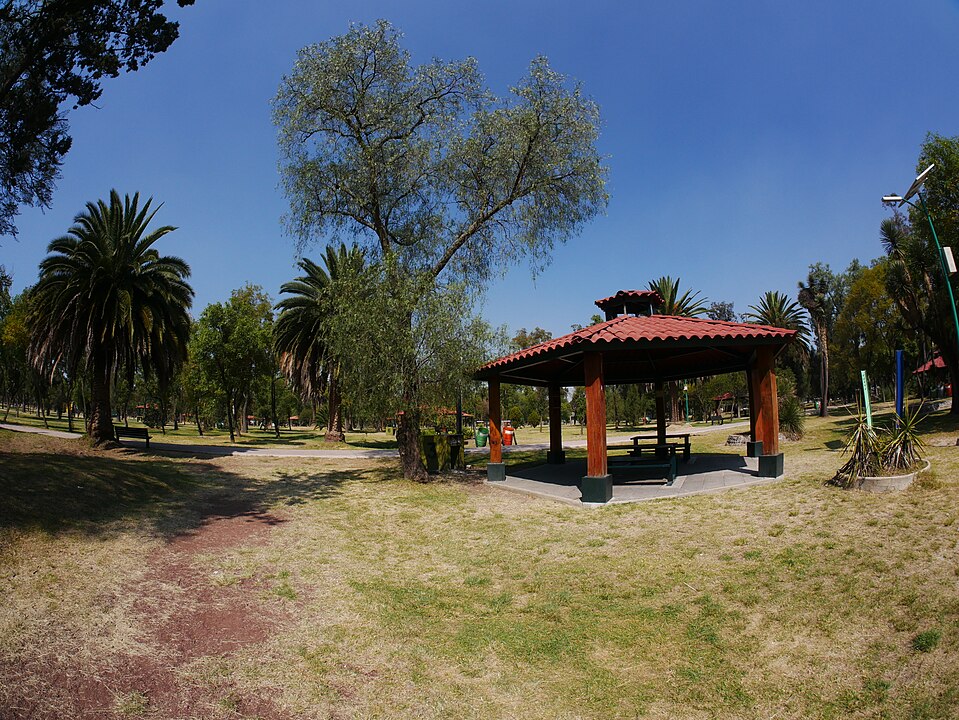
In Bosque de San Juan de Aragón, you can find:
-
Pool for swimming. It cost just 61 Mexican pesos per person. The price was last updated in July 2023.
-
An artificial lake.
-
Park sculptures.
-
Dog park for strolling your pet.
-
Skate park.
-
Track for cycling.
-
Sports area for football or squash.
-
The park is open from Tuesday to Sunday from 6 am to 6 pm and the entrance is free.

Bosque de San Juan de Aragón Park is very close to the Benito Juarez airport in Mexico City. If you have just a few hours to wait in Mexico City, you can get there by taxi in 5-10 minutes and spend your waiting time there. It could be a good resting place for business travelers and a nice weekend escape for expats in Mexico City.
You can check more about Balneario San Juan de Aragón here:
https://www.archivo.cdmx.gob.mx/vive-cdmx/post/balneario-san-juan-de-aragon
How much time do you need to explore Bosque de San Juan de Aragón Park?
1 day. The park is big and it is located far from the typical tourist attractions. Get a whole day for it, so you can have enough to walk around, do exercises, or even swim.
How to get to Bosque de San Juan de Aragón Park?
-
Metro (subway). It is really easy to get to Juan de Aragón Park. You need to use Line B (Green and Grey Line) and get off at Bosque de Aragón station. The park is just outside of the metro station.
-
Metrobus. You can use the Metrobus Line 6 (Pink Line) and get off at Villa Aragón station.
-
Car. You can easily drive there and find free parking.
How much to spend in Bosque de San Juan de Aragón Park?
The entrance is free. There are no restaurants there, just a coffee place, so you better prepare food and drinks in advance. You can get some from the entrance to the park, just outside the metro and it will cost you less than 100 Mexican pesos per person, so less than 200 Mexican pesos for 2. If you want to swim too, count 61 Mexican pesos per person and that will make the account at just above 300 Mexican pesos for 2 people.
Tezozomoc park (Parque Tezozomoc)
Not so many people know about Tezozomoc Park. This is a truly hidden park in Mexico City. It is a very beautiful and large park, located in the north of the city. It is a great place to play football or other sports. You can go around on a bicycle or run. There are also water wheels, so you can enjoy pedaling in the artificial lake. It is a large lake and the environment is very pleasant.
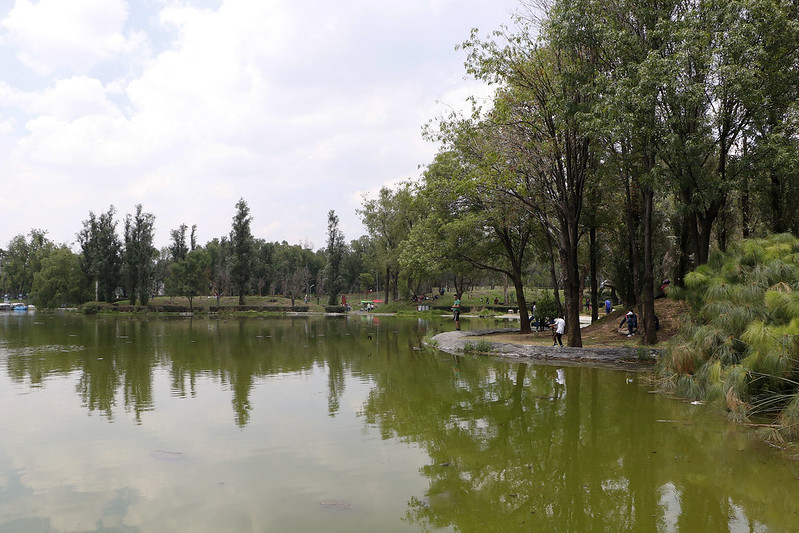
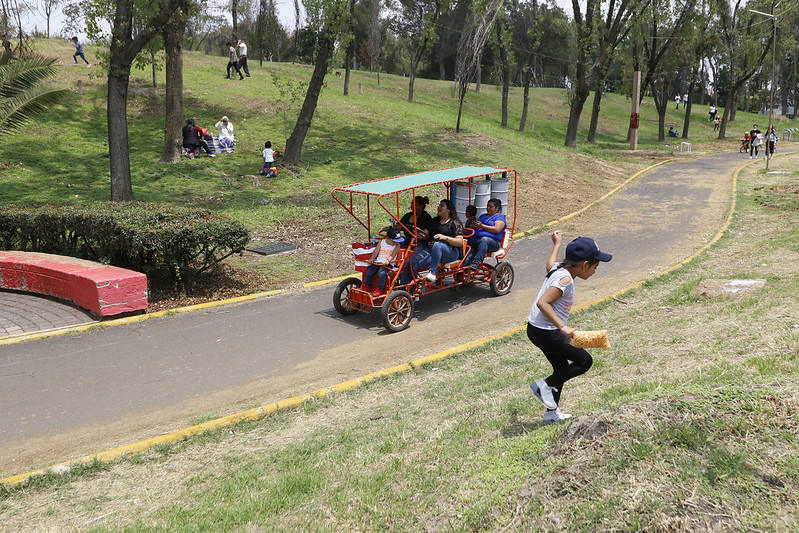
The Tezozomoc Park is very kid-friendly and there are often children's activities organized by the municipality or local schools.
Tezozomoc Park has a free entrance and working hours from 6 am to 6 pm.
How much time do you need to explore Tezozomoc Park?
You will need 1 day. The park is big and it is located far from the typical tourist attractions. Get a whole day for it, so you can have enough to walk around, do exercises, or pedal a boat in the lake.
How to get to Tezozomoc Park?
-
Metro (subway). It is really easy to get to Tezozomoc Park. You need to use Line 7 (Orange Line) and get off at El Rosario station. The park is 5 minutes by walking from there. You can also use metro Line 6 (Red Line) and get off at Tezozómoc station. From there you need to walk west for 5 minutes and you will arrive.
-
Car. You can drive there and find free parking.
How much to spend in Tezozomoc Park?
The entrance is free. There are no restaurants there, just fast food, so you better prepare food and drinks in advance. You can get some from the entrance to the park, just outside the metro and it will cost you less than 100 Mexican pesos per person, so less than 200 Mexican pesos for 2.
Outro
So, now you know 3 more hidden parks in Mexico City. You can be one of the few expats to visit them. they feel a lot different than Chapultepec Park or Parque España in Condesa.
All of them are worth your time. You can swim, paddle a boat, or just go for a nice stroll with your dog. They are located a bit further from the center, but there is a good metro (subway) system, so you can still reach them.
If you are searching for good parks to have a nice experience with your family, you can also check the most famous parks in Mexico City.
